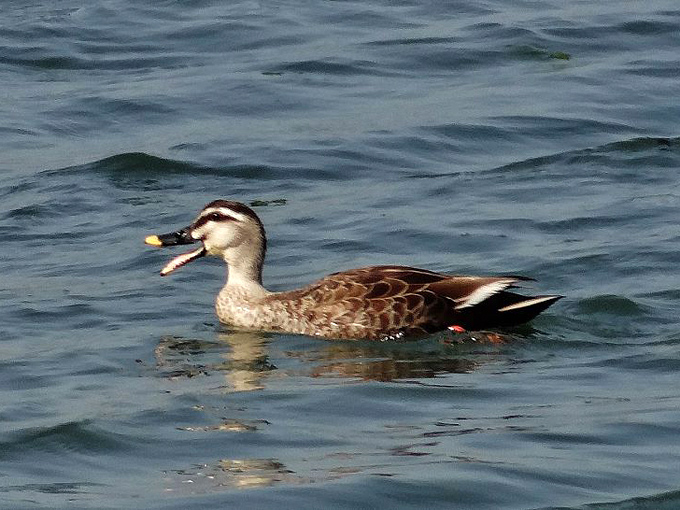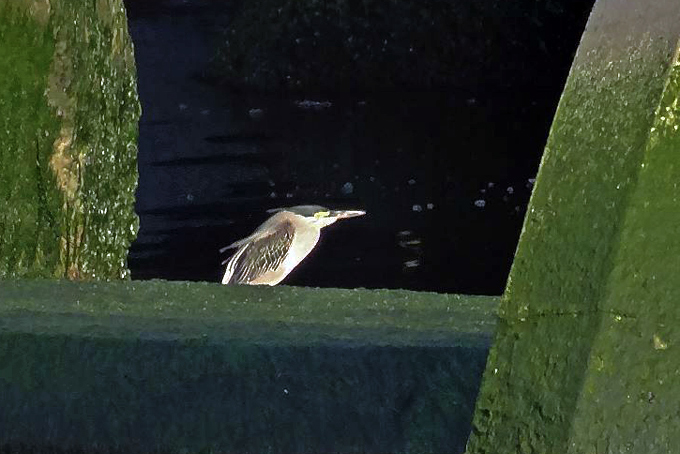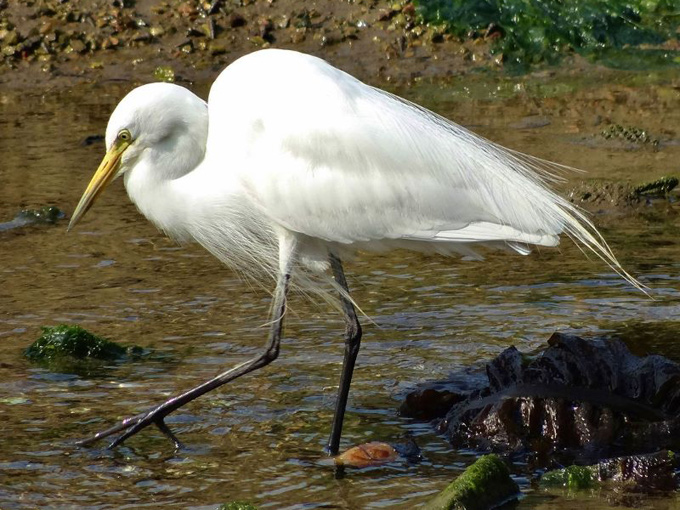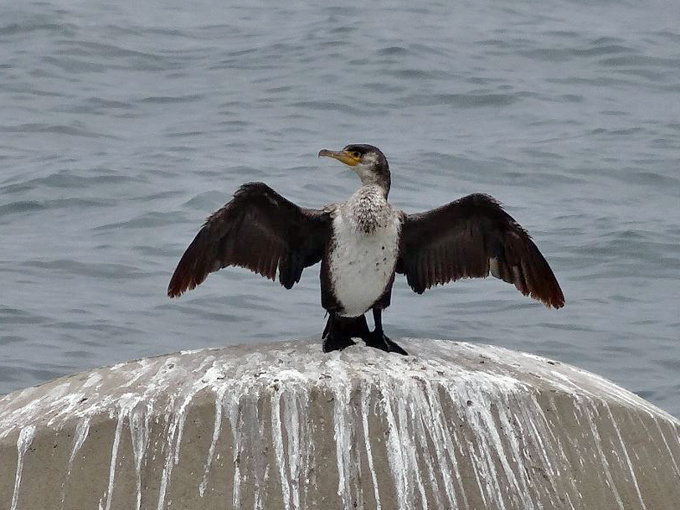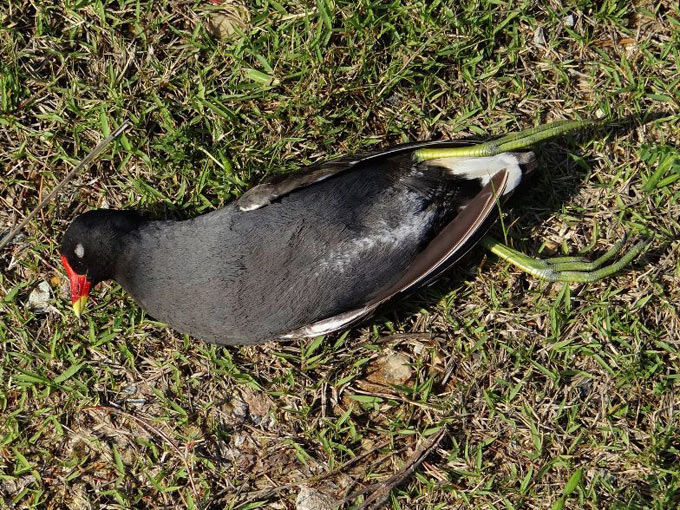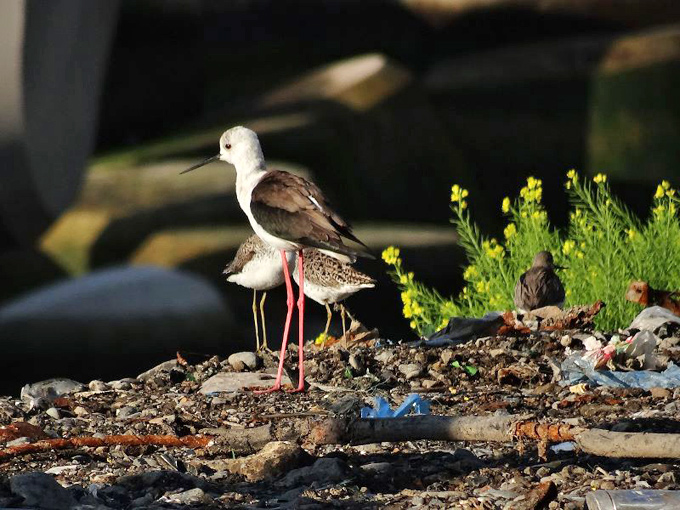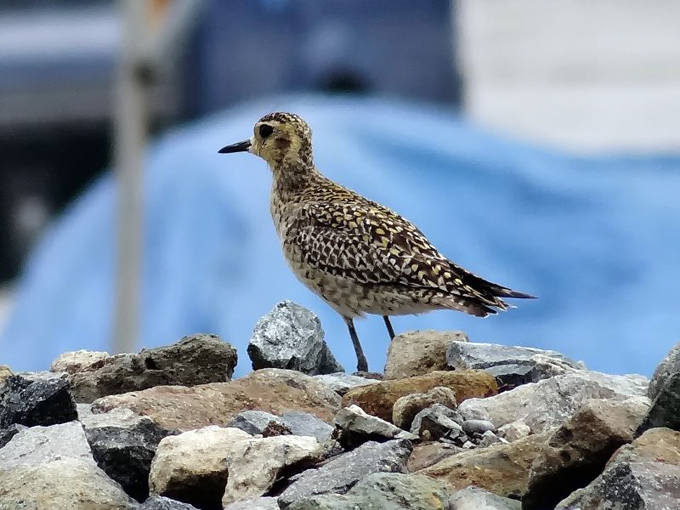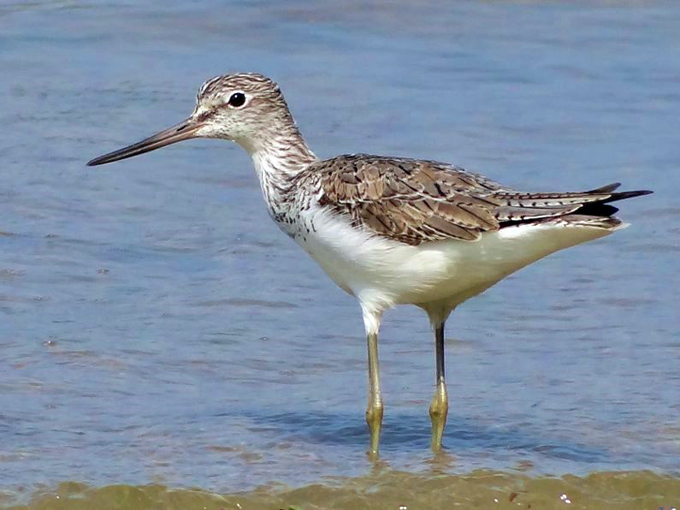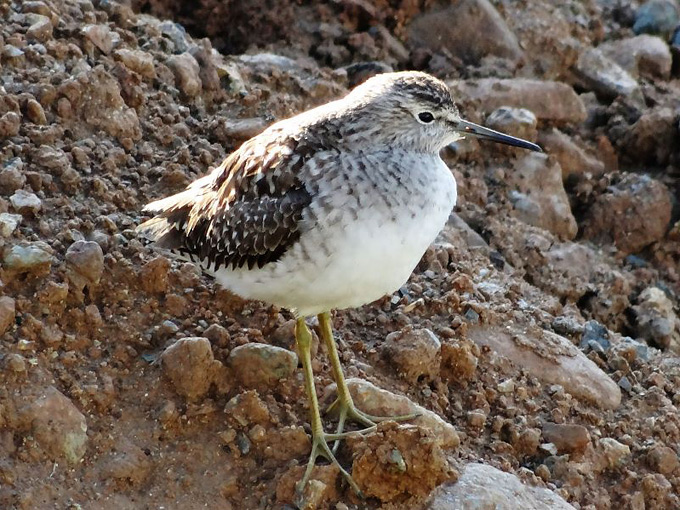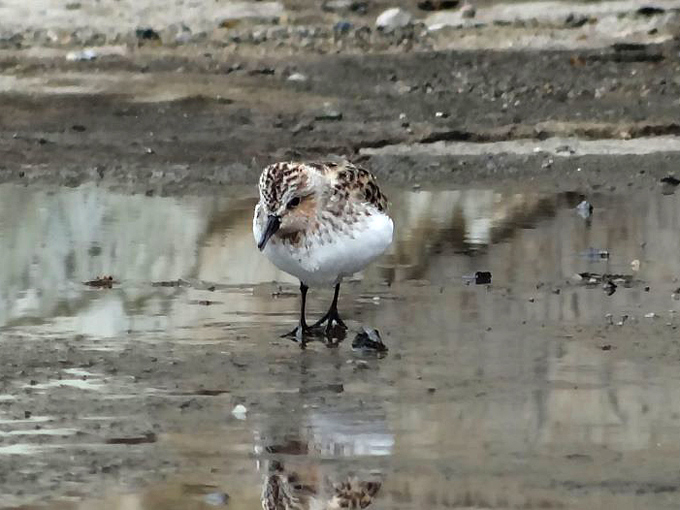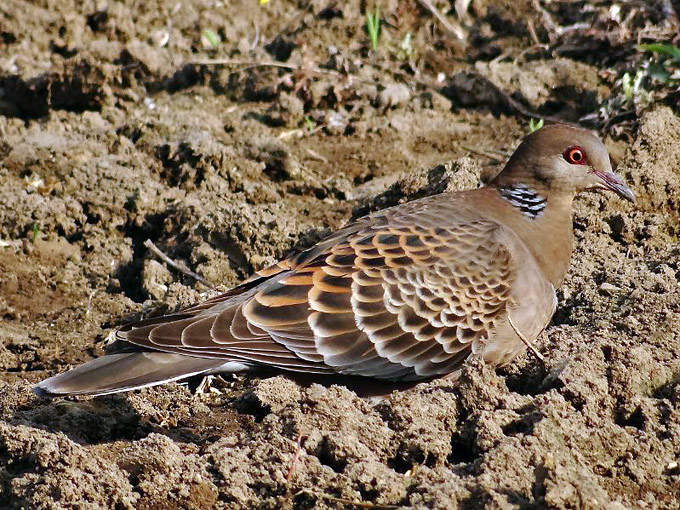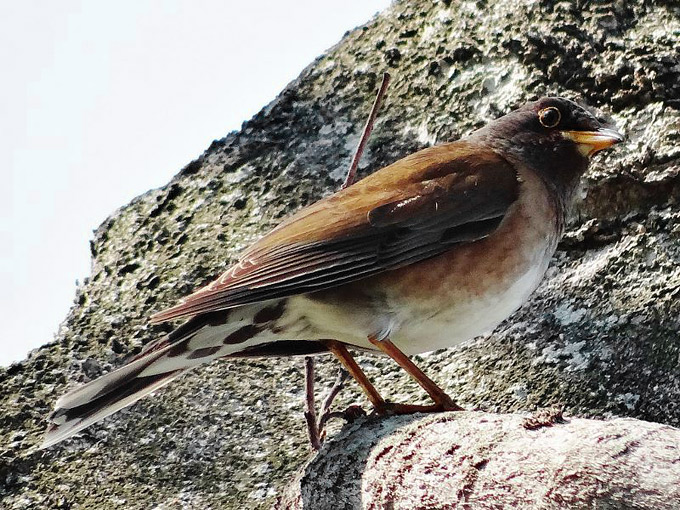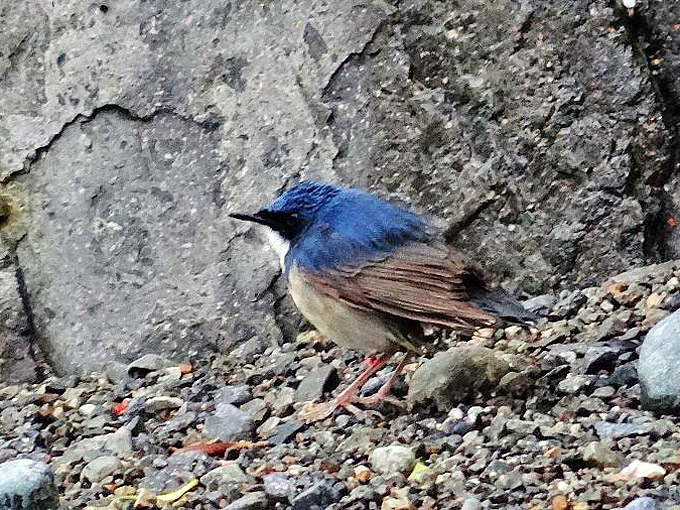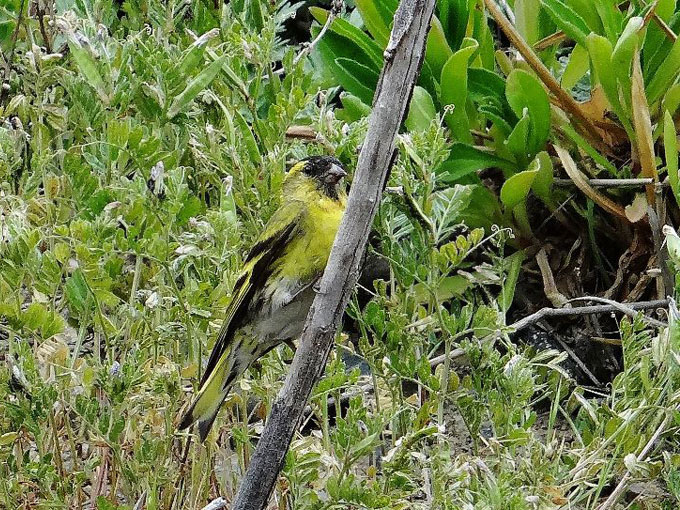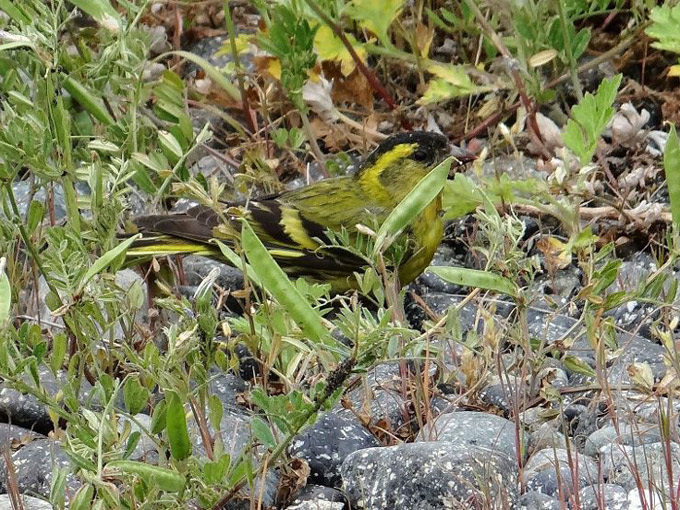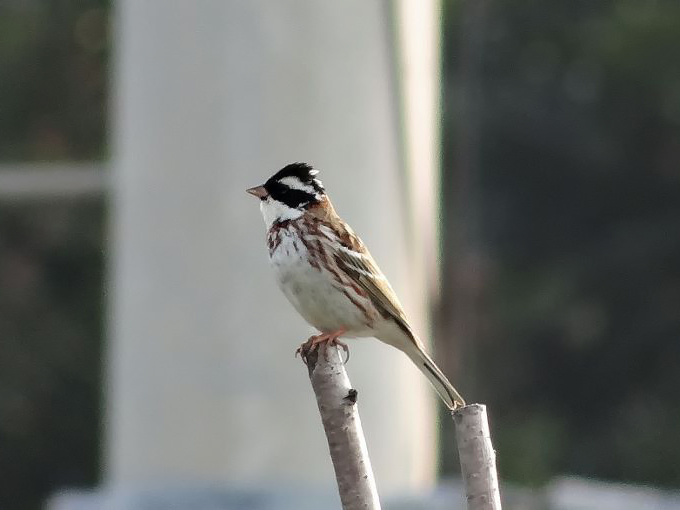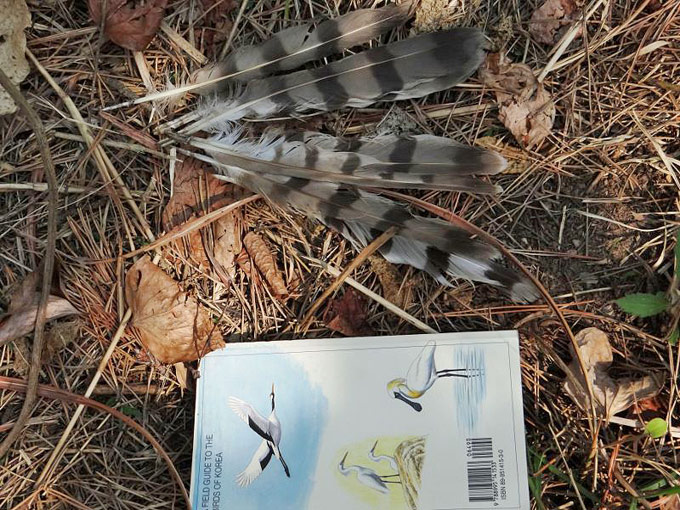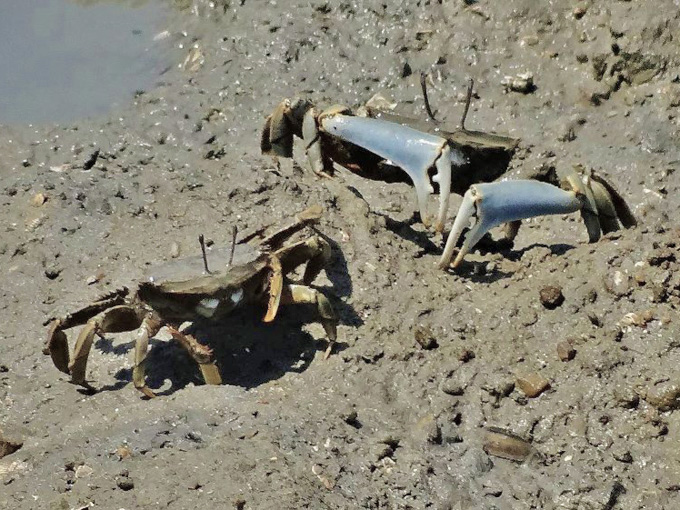This page contains two reports from two birders of their trip.
The first one is in English and written by Philippe Malenfert, the second one is is in French and written by Jean-Jacques Guillou.
We have added the English species names to the French report so that all readers can easily understand names, dates and numbers.
April 20 - May 1 2014 (+ Mokpo area on May 2)
(With additional editing and layout by Birds Korea)
All observations and images by P. M.
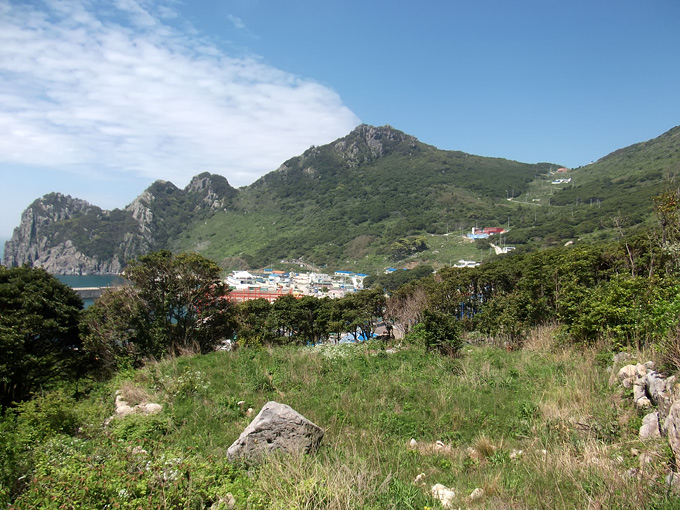

The first part of this trip was spent on Heuksan Island (April 20-25th). The weather there was very calm, sunny and mostly warm for the season. The migration was barely visible on the northern part of the island and very few birds were on stopover. Hopefully, the conditions quickly changed in the second part of the trip on Gageo Island as the awaited rain came on April 27th and lasted all day and following night in a quite strong south-west spell. From then, there was an obvious increase in bird numbers and diversity. The main arrival took place on april 29th-30th and was huge. This latter day, we were lucky enough to bird both on Gageo and Heuksan islands. On Heuksan, the diversity increased also sharply (with the notable exception of flycatchers) and May 1st was a really birdy day there.
I would like to thank everyone at Birds Korea for their help in the preparation or during the trip (including a key revitalizing Italian food stage!), and most of all for their invaluable work in describing the birdlife of the country and in raising awareness of its big value. I also thank the National Park team for their patience with me, their answers to my many questions and the sharing of bird news.
The numbers given in the species list hereafter must be considered as low minima. The main reasons for that is because the counts were made on selected time only and because same places were very often visited twice a day - or more - with only the higher count registered. Furthermore, I didn’t include estimations as I’m not experienced enough, neither in the country’s avifauna nor in the places I visited, to be able to confidently deal with it.
Species list
- Gadwall Anas strepera.
A pair in Mokpo on 02/05. - Falcated Duck Anas falcata.
One male in Mokpo on 02/05. - Eurasian Wigeon Anas Penelope.
Still some overwintering birds in Mokpo on 02/05. - Eastern Spot-billed Duck Anas zonorhyncha. At least 11 individuals on Heuksan during my stay.
- Northern Shoveler Anas clypeata.
One pair in Mokpo on 02/05. - Eurasian Teal Anas crecca.
One female on 21 and 22/04 at Heuksan - Baenanggimi. - Japanese Quail Coturnix japonica.
One on Gageo on 29/04. - Arctic Loon Gavia arctica.
Three were seen at sea from the ferry to Gageo on 25/04 and one bird was in the harbour of 1-Gu that day. The latter individual was seen up to 27/04. - Little Grebe Tachybaptus ruficollis.
Three on 21/04 on Heuksan. One in the harbour of 1-Gu on Gageo on 27/04. - Great Crested Grebe Podiceps cristatus.
A bit surprisingly, many individuals were still in the harbour of both islands, all of them in winter plumage. Maximum was 10 on Gageo on 27/04 and 3 on Heuksan from 21 to 23/04. - Black-faced Spoonbill Platalea minor.
The bird that crossed the road just above the bus I was in near Incheon Airport was the first surprise of the trip. A welcoming bird in a not-so-welcoming environment! - Black-crowned Night Heron Nycticorax nycticorax. An adult on 24/04 on Heuksan. One on 28/04 on Gageo.
- Striated Heron Butorides striata.
One on 30/04 on Gageo. - Chinese Pond Heron Ardeola bacchus.
Three on migration on Gageo on 27/04; another migrating bird on 28/04; yet another one on 29/04; one on 30/04. - Eastern Cattle Egret Bubulcus coromandus.
First bird seen on Gageo on 25/04; three on 28/04; four on 29/04; 6+ on 30/04. On Heuksan: five on 01/05. - Grey Heron Ardea cinerea.
Common and seen daily. Five on 21/04; 3 on 22 and 23/04; 7 on 24/04 on Heuksan. One only bird on 25/04 on Gageo. The next day, ten migrant birds had to stop over in 1-Gu because they couldn’t see the pass due to the mist. They tried for several hours to find their way but they eventually roosted for the evening and the night. Sixty migrants on 29/04 and still fifty the next day. - Great Egret Ardea alba.
Five on 22/04 on Heuksan. On Gageo: two on 25/04; 25 on 28/04; again 25 migrants on 29/04 and another 30 on 30/04. - Intermediate Egret Egretta intermedia.
Two on 20/04; 4+ on 21/04; two on 22/04 on Heuksan. On Gageo: three on 25/04; one on 26/04; five on 28/04; ten migrants on 29/04; eight on 30/04. - Little Egret Egretta garzetta.
Three on 20/04; one on 21/04; one on 22/04 on Heuksan. On Gageo: nine on 28/04; fourteen on 29/04; twenty on 30/04. - Pelagic Cormorant Phalacrocorax pelagicus.
One in the harbour of 1-Gu on Gageo, from 25/04 to 29/04. This bird was moulting to adult plumage. - Great Cormorant Phalacrocorax carbo.
One in Mokpo-Namhang on 02/05. - Temminck’s Cormorant Phalacrocorax capillatus.
One on 21/04 and two on 22 and 24/04 in Heuksan’s harbour. On Gageo: maximum of three on 28/04. - Chinese Sparrowhawk Accipiter soloensis.
One on Heuksan on 30/04. - Japanese Sparrowhawk Accipiter gularis.
One on 20/04, one on 23/04 and one on migration on 24/04 on Heuksan. On Gageo: two on 30/04. - Eurasian Sparrowhawk Accipiter nisus.
Only one definite observation: one bird on 30/04 on Heuksan. - Black Kite Milvus migrans. One bird on migration on Heuksan on 23/04.
- White-tailed Sea-eagle Haliaeetus albicilla.
One near-adult bird on Heuksan on 23/04. - Grey-faced Buzzard Butastur indicus.
Only seen on Heuksan: one roosted on a tree on 20/04 and three stopped for a while on 01/05 and then left the island at midday. - Eastern Buzzard Buteo japonicus.
One migrating bird on Gageo on 26/04 and one there in the quarry on 30/04. - Eurasian Hobby Falco subbuteo.
One bird on migration on 30/04 on Gageo. - Peregrine Falcon Falco peregrinus.
A pair was seen daily on Heuksan. One bird on a small island between Heuksan and Gageo on 25/04. Two pairs on Gageo, very often seen patrolling the slopes. - Common Moorhen Gallinula chloropus.
One in the village of Jin-ri on 30/04. Maybe the same bird was found dead on 01/05 without any apparent wounds. - Far Eastern Oystercatcher Haematopus ostralogus.
Two birds were seen from the ferry to Heuksan on 20/04. - Black-winged Stilt Himantopus himantopus.
One male and one female on Gageo on 29/04; one female on 30/04. On Heuksan: one on 30/04. - Grey-headed Lapwing Vanellus cinereus.
The final surprise of the trip, within the last hour of birding on Heuksan on 01/05, was that bird in flight at low altitude that kindly uttered some loud and sharp calls to ensure it wouldn’t stay unnoticed. - Pacific Golden Plover Pluvialis fulva.
One on 28 and 29/04 on Gageo. Seven birds in a pasture on 01/05 on Heuksan, together with two Little Curlews. Two of them were almost in full breeding plumage. - Kentish Plover Charadrius alexandrinus.
Common in Mokpo-Namhang on 02/05. - Mongolian Plover Charadrius mongolus.
Two on Heuksan on 30/04 and eight together on 01/05. - Pin-tailed Snipe Gallinago stenura.
Three flushed birds on 21/04 and one on 23/04 were assumed to be this species. One on 01/05 (still on Heuksan). - Common Snipe Gallinago gallinago.
One on 20/04 and one on 22/04 on Heuksan. - Black-tailed Godwit Limosa limosa melanuroides.
One on 30/04 on Heuksan. - Bar-tailed Godwit Limosa lapponica.
Very common in Mokpo-Namhang on 02/05. - Little Curlew Numenius minutus.
One on 28 and 29/04 on Gageo. Two birds in a pasture on Heuksan on 01/05, together with seven Pacific Golden Plovers, were friendly enough to allow very good views. - Whimbrel Numenius phaeopus.
One on 23/04 on Heuksan and one on 28/04 on Gageo. - Eurasian Curlew Numenius arquata. Several were seen from the bus to Incheon on 02/05.
- Common Redshank Tringa totanus.
Three on 30/04 on Heuksan. - Marsh Sandpiper Tringa stagnatilis.
One on 22 and 23/04, four on 30/04 and one on 01/05 on Heuksan. One on 28/04, one on 29/04 and one on 30/04 on Gageo. - Common Greenshank Tringa nebularia. One on 20/04; one on 21/04; one on 22/04; one on 24/04; two on 25/04; two on 30/04 and 01/05 on Heuksan. On Gageo: one on 25/04; one on 26/04; two on 28/04; one on 29/04; three on 30/04.
- Green Sandpiper Tringa ochropus.
Two on 20/04 and one on 22/04 on Heuksan. One on 29/04 on Gageo. - Wood Sandpiper Tringa glareola.
Three on 21/04; nine on 24/04; ten on 30/04 on Heuksan. One on 25/04 and one on 28/04 on Gageo. - Grey-tailed Tattler Tringa brevipes.
One on Gageo on 28/04 and 29/04. Four on Heuksan on 30/04 and two on 01/05. - Terek Sandpiper Xenus cinereus.
One on 20/04, eleven on 30/04 and two on 01/05 on Heuksan. On Gageo: one on 28/04; two on 29/04; four on 30/04. - Common Sandpiper Actitis hypoleucos.
Two on 20/04; one on 21/04; two on 24/04; one on 25/04; 6 on 30/04 on Heuksan. On Gageo: one on 26/04; 5+ on 28/04; four on 29/04. - Ruddy Turnstone Arenaria interpres.
Many birds in Mokpo-Namhang on 02/05, including one of Andreas’ old friends (a flagged individual that is long-known on the spot). - Red-necked Stint Calidris ruficollis.
One on 28/04, four on 29/04 and two on 30/04 on Gageo. Two on 30/04 on Heuksan. - Temminck’s Stint Calidris temminckii. One on 30/04 on Gageo.
- Long-toed Stint Calidris subminuta.
One on 30/04 on Gageo. - Sharp-tailed Sandpiper Calidris acuminata.
One on 28/04 and 29/04 on Gageo. One on 30/04 and 01/05 on Heuksan. - Dunlin Calidris alpina.
Very common in Mokpo-Namhang on 02/05. - Ruff Philomachus pugnax.
A female on 29/04 on Gageo. - Oriental Pratincole Glareola maldivarum.
One on 30/04 on Heuksan. - Black-tailed Gull Larus crassirostris.
Seen daily on both islands. - Vega Gull Larus vegae.
Common and seen daily. - Mongolian Gull Larus mongolicus.
Common and seen daily. - Little Tern Sterna albifrons.
Several birds in Mokpo-Namhang on 02/05. - Ancient Murrelet Synthliboramphus antiquus.
Two birds from the ferry to Gageo on 25/04. - Rhinoceros Auklet Cerorhinca monocerata.
Two small parties of 3 and 13 birds were well seen at close range on a flat sea from the ferry to Heuksan on 20/04. - Black Wood Pigeon Columba janthina.
On Gageo, one or two birds came daily at close range to feed on berries in the vicinity of 1-Gu. - Oriental Turtle Dove Streptopelia orientalis.
Very common on Heuksan. Only one on 28/04 on Gageo. - Oriental Cuckoo Cuculus optatus.
Heard from 24/04 onwards on Heuksan. - Himalayan Swiftlet Aerodramus brevirostris.
One on 21/04 at Heuksan-Baenanggimi and above the nearby reservoir. Could this species be a little more regular than we thought, especially on Heuksan Island ? - Pacific Swift Apus pacificus.
Three came to drink at Heuksan – Baenanggimi and 10 were flying above Ye-ri on 23/04; 20 on 24/04 on Heuksan. On Gageo: a few high in the sky on 25/04; 30 on 28/04; 20 on 29/04. - House Swift Apus nipalensis.
One in the evening amongst swallows on 25/04 on Gageo. - Common Kingfisher Alcedo atthis.
One on 20/04 and 21/04, and one on 01/05 on Heuksan. One on 28/04 and 29/04 on Gageo. - Eurasian Hoopoe Upupa epops.
One on 26/04 on Gageo. - Grey-headed Woodpecker Picus canus.
One was seen from the train to Mokpo on 19/04. - Common Kestrel Falco tinnunculus.
One male in Mokpo, museums area, on 02/05. - Ashy Minivet Pericrocotus divaricatus.
One in flight on Heuksan on 21/04 and two together on 01/05. On Gageo: one on 28/04, two on 29/04 and one on 30/04. - Bull-headed Shrike Lanius bucephalus.
Youngs already fledged in Ye-ri on 23/04! Two families with at least three and one respectively. - Long-tailed Shrike Lanius schach.
One on Heuksan on 21/04 and 22/04. - Black Paradise Flycatcher Terpsiphone atrocaudata.
One on 30/04 on Gageo. - Eurasian Magpie Pica pica.
Very common on the mainland. - Carrion Crow Corvus corone.
A very common species on the mainland. - Varied Tit Sittiparus varius.
On Heuksan : one nest-feeding on 20/04 at the exact same spot as last year; 2 on 21/04; 3 singing birds on 22/04; 2 other birds on 23/04; 8 on 24/04. An adult was feeding a fledged young on 01/05. This species seemed either more numerous this spring or ahead of its usual breeding phenology so that birds were more active. Only one contact on Gageo: a bird in the quarry on 29/04. - Eastern Great Tit Parus minor.
Commonly heard or seen on Heuksan, for instance 12 birds on 24/04. - Light-vented Bulbul Pycnonotus sinensis.
Only 4 on 20/04 and 23/04 on Heuksan. On Gageo: 6 on 25/04 was the daily maximum. - Brown-eared Bulbul Hypsipetes amaurotis.
Very common (and noisy!) on both islands. For instance, 25 individuals on 20/04 on Heuksan and 10 on 25/04 on Gageo. - Sand Martin Riparia riparia. One on 28/04 on Gageo stopped over for the night. Probably the same bird was seen the next day in the morning.
- Barn Swallow Hirundo rustica.
Common on stopover or on active migration. 50 on 20/04; 80 on 21/04; 40 on 23/04 on Heuksan. On Gageo : 250+ on 25/04 and 100+ on 28/04. - Asian House Martin Delichon dasypus.
45 on 28/04 on Gageo and just one there the next day. - Red-rumped Swallow Cecropis daurica.
One on 20/04; one on 21/04; 8+ on 23/04; 15 on 24/04 on Heuksan. On Gageo: 20 on 25/04; 10 on 26/04; 20 on 28/04. - Japanese Bush warbler Horornis diphone.
Heard every day (e.g. at least five singing birds on 20/04 in Jin-ri and five also on 28/04 in 1-Gu) but seldom seen. - Korean Bush Warbler Horornis canturians.
I still have some trouble to separate canturians from diphone but a few individuals on Heuksan were clearly identified as canturians from the song. - Asian Stubtail Urosphena squameiceps.
One singing bird on 21/04 and one on 24/04 on Heuksan. On Gageo: one on 25/04; four on 26/04; six on 28/04; four on 29/04. These numbers are of course minima as several birds could be on one spot when we counted just one for the whole day. - Long-tailed Tit Aegithalos caudatus.
As Varied Tit, seemed quite numerous this spring. Three on 21/04; one on 22/04; five on 23/04; 15 on 24/04 on Heuksan. - Dusky Warbler Phylloscopus fuscatus.
Only one on 25/04 on Heuksan. - Yellow-browed Warbler Phylloscopus inornatus.
Strikingly low numbers! Only two on 24/04 and 6+ on 01/05 on Heuksan. One on 25/04 and one on 30/04 on Gageo. - Pale-legged Warbler Phylloscopus tenellipes.
At least one on Gageo on 28/04 and 2+ on 30/04. At least four on 01/05 on Heuksan. - Sakhalin Leaf Warbler Phylloscopus borealides.
One on 01/05 on Heuksan. The ID was based on morphology and slightly different pitch in calls. This Leaf Warbler was calmly hunting insects in low vegetation as an Eastern Crowned was feeding more nervously higher in the nearby trees. This allowed me for a comparison of both morphology and calls. The first obvious difference is that the alleged Sakhalin Leaf Warbler had a grey head (crown and nape) and upper mantle. I mean not greenish or brownish but rather plain grey. The contrast was striking with the main part of the mantle and with the flight feathers (very clearly fringed with greenish tones). Secondly, the tarsus were a lot darker than typical Pale-legged. The calls were very similar but I noticed a tiny difference in the pitch (slightly lower in the alleged Sakhalin). The fact that this bird was feeding in low vegetation only is also intriguing to me but this might be related to its condition. - Eastern Crowned Warbler Phylloscopus coronatus.
Two on 23/04 and another two on 01/05 on Heuksan. Four on 28/04 on Gageo and at least two on 29/04. - Oriental Reed Warbler Acrocephalus orientalis.
One on Gageo on 28/04 and one on 29/04. One on 01/05 on Heuksan. - Japanese White-eye Zosterops japonicus.
Three on 21/04; ten on 23/04 including many singing birds; twenty on 24/04; four on 01/05 on Heuksan. On Gageo: eight on 26/04; seven on 28/04 including a pair feeding a fledged young; several birds were building the nest on 29 and 30/04. - White-cheeked Starling Spodiopsar cineraceus.
Three on 23/04, one on 24/04 and eight on 30/04 on Heuksan. One on 30/04 on Gageo. - Daurian Starling Agropsar sturninus.
One female on 25/04 on Heuksan. - Chestnut-cheeked Starling Agropsar philippensis.
Good numbers. Six on 26/04 on Gageo; 25 on 28/04; 15 on 29/04; 15 on 30/04. On Heuksan, a flock of 28 birds stopped over for a few minutes on 01/05. - White-shouldered Starling Sturnia sinensis.
One on 28/04 on Gageo. This bird didn’t look like the one that was pictured on the island the previous week. - Grey-backed Thrush Turdus hortulorum.
Only seen on Heuksan: one male and one female on 21/04, one on 23/04, one on 24/04 and another one on 01/05. - Grey Thrush Turdus cardis.
A male on 21/04 at Heuksan-Baenanggimi and a female on 24/04 in Jin-ri. - Eyebrowed Thrush Turdus obscurus.
One male on 20/04 and another one on 23/04 on Heuksan. One on 28/04 and one on 29/04 on Gageo. - Pale Thrush Turdus pallidus.
Very common on Heuksan, much less so on Gageo. - Brown-headed Thrush Turdus chrysolaus.
Regular on Gageo but rather hard to see well. Five on 26/04; three on 28/04; two on 29/04; two on 30/04. One only bird was seen on Heuksan on 01/05. - Dusky Thrush Turdus eunomus.
Very low numbers! Two on 21/04, one on 24/04 and one on 01/05 on Heuksan. One sole bird on Gageo on 28/04. - Asian Brown Flycatcher Muscicapa latirostris.
The only flycatcher with decent numbers. Six on 20/04; three on 21/04; two on 23/04; one on 24/04; one on 25/04 on Heuksan. On Gageo: three on 28/04, seven on 29/04 and a maximum of ten on 30/04. - Blue-and-white Flycatcher Cyanoptila cyanomelana.
One male on 20/04; three males on 21/04; one male on 30/04; a male and a female on 01/05 on Heuksan. On Gageo: one male on 28/04. - Siberian Blue Robin Larvivora cyane.
Two males on 28/04 and another two on 29/04 on Gageo. - Rufous-tailed Robin Larvivora sibilans.
At least one on 28/04 on Gageo. - Siberian Rubythroat Calliope calliope.
Two on 28/04 on Gageo, including a singing male that showed well the next day again. One male there in the quarry on 30/04. - Red-flanked Bluetail Tarsiger cyanurus.
Just one female on 23/04 on Heuksan. - Yellow-rumped Flycatcher Ficedula zanthopygia.
One male on 23/04 on Heuksan. - Narcissus Flycatcher Ficedula narcissina.
Only males were seen. One on 21/04; two on 24/04; one on 30/04; two on 01/05 on Heuksan. On Gageo: one on 28/04 and one on 29/04. - Daurian Redstart Phoenicurus auroreus.
One male on 24/04 on Heuksan. - Blue Rock Thrush Monticola solitarius.
Maximum of four birds on 25/04 on Gageo. - Stejneger's Stonechat Saxicola stejnegeri.
Quite common but in varying numbers from one day to another. Only 2 on 20/04 and 21/04; 12+ on 23/04; two on 24/04 on Heuksan. On Gageo: one on 28/04; two on 29/04; 15 on 30/04. - Eurasian Tree Sparrow Passer montanus.
One or two on Gageo on 26 and 28/04. - Western Yellow Wagtail Motacilla flava thunbergi (“plexa”).
One on 27/04 on Gageo. - Eastern Yellow Wagtail Motacilla tschutschensis.
Common and seen daily, including taxa identified as tschutschensis, taivana and macronyx. On 28/04, 60+ birds were counted around 1-Gu. There were 100+ birds there on 29/04, including 10 taivana.
Still big number on 30/04, as the proportion of taivana increased. - Citrine Wagtail Motacilla citreola.
Only seen on Gageo. Two males and a female on 28/04; one male and one female on 29/04 and 30/04. - Grey Wagtail Motacilla cinerea.
Common close to water, though in varying numbers from one day to another. four on 20/04; two on 21/04; three on 22/04; five on 24/04 on Heuksan. Ten on 25/04 on Gageo; 60 there on 28/04 at dawn after strong winds; still 15 on 29/04. - White Wagtail Motacilla alba ocularis were seen daily. Single leucopsis were seen on 25/04 on Gageo and on 01/05 on Heuksan. At dawn on 28/04, 180 birds were counted after strong winds in the previous night. They were still over a hundred on 29/04.
- Richard’s Pipit Anthus richardi.
One on 23 and 24/04 on Heuksan. On Gageo : two on 29/04 and twenty-five on 30/04. - Olive-backed Pipit Anthus hodgsoni.
60 on 20/04; 40 on 21/04; 30 on 22/04; 40 on 23/04; 15 on 24/04; 100+ on 01/05 on Heuksan. On Gageo: 8 on 25/04; 60+ on 28/04; 80 on the ground on 29/04 and several hundreds on active migration; 1000 around 1-Gu on 30/04. - Rosy pipit Anthus roseatus.
One found by the NPMBC team on Heuksan on 30/04. A beautiful species! - Red-throated Pipit Anthus cervinus.
Five on 21/04; one on 23/04; 30+ on 01/05 on Heuksan. On Gageo: five on 25/04; 15+ on 28/04; 50+ on the ground on 29/04 and dozens of birds on migration; 200 around 1-Gu on 30/04. - Buff-bellied Pipit Anthus rubescens.
One on 21/04 and two on 22/04 on Heuksan. Two on 30/04 on Gageo. - Brambling Coelebs montifringilla.
On Heuksan: a flock of 25 birds on 20/04; 5 on 21/04; a few on 22/04; two on 23/04; 50 on 01/05. On Gageo: two females on 28/04; several hundred on active migration on 29/04; 50 on 30/04. - Hawfinch Coccothraustes coccothraustes.
One on Heuksan on 23/04. - Chinese Grosbeak Eophona migratoria.
One singing bird on 23/04; four on 25/04 on Heuksan. One male on 28/04, one on 29/04 and six on 30/04 on Gageo. - Grey-capped Greenfinch Chloris sinica.
One on 01/05 on Heuksan. - Eurasian Siskin Spinus spinus.
Strong arrival on 30/04 on Gageo as 200 birds were counted around 1-Gu alone. Fifty on 01/05 on Heuksan. - Tristram’s Bunting Emberiza tristrami.
Surprisingly only seen on 01/05 - a male - on Heuksan. - Chestnut-eared Bunting Emberiza fucata.
Two on 23/04; one on 25/04; eight on 01/05 on Heuksan. One only bird on 25/04 on Gageo. - Little Bunting Emberiza pusilla.
Two on 20/04 (one of them singing almost continuously); five on 21/04; three on 22/04; 8+ on 23/04; three on 25/04; 15 on 01/05 on Heuksan. On Gageo: one on 25/04 and five on 28/04. Big arrival on 29/04 as 700+ birds were on migration above 1-Gu. The next day, 1000 birds were counted on the ground! - Yellow-browed Bunting Emberiza chrysophrys.
Two on 20/04; one on 21/04; three on 23/04; ten on 24/04; five on 25/04; 25 on 01/05 on Heuksan. On Gageo: four on 25/04; 500 on active migration on 29/04 and 400 (!) grounded around 1-Gu on 30/04. - Rustic Bunting Emberiza rustica.
One male in full breeding plumage on 24/04; two on 25/04 at another place on Heuksan. - Yellow-throated Bunting Emberiza elegans.
A pair was building a nest on 21/04 on Heuksan. I strongly suspected local breeding last spring, here comes the evidence. - Yellow-breasted Bunting Emberiza aureola.
Three on 01/05 on Heuksan. - Yellow Bunting Emberiza sulphurata.
Eight on 24/04 and three on 25/04 on Heuksan. One on 28/04, one on 29/04 and one on 30/04 on Gageo. - Black-faced Bunting Emberiza spodocephala.
Three on 20/04; three on 21/04; two on 23/04 on Heuksan. On Gageo: two on 25/04 and at least three on 28/04. Huge arrival on 29/04 as 800+ birds were counted on migration above 1-Gu. The next day, 1000 birds were counted on the ground!
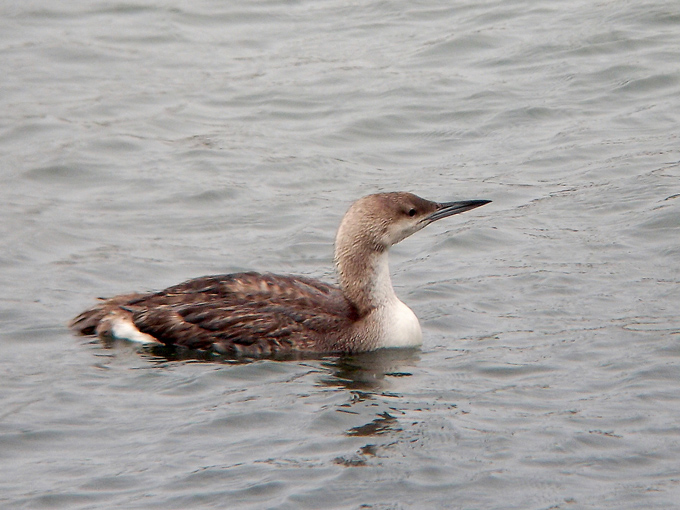
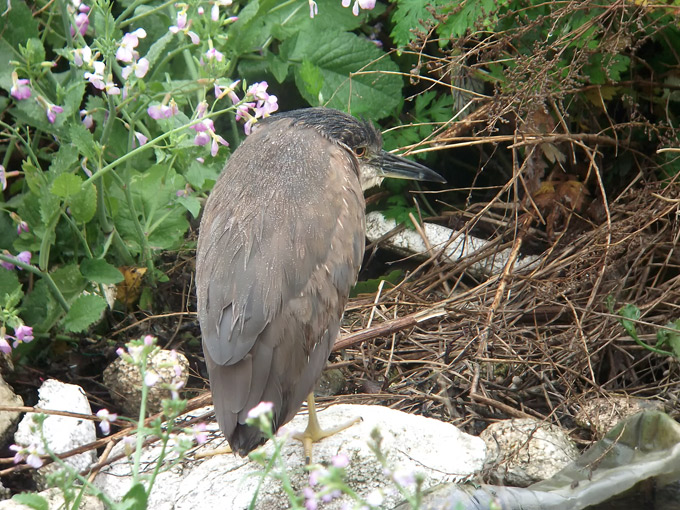
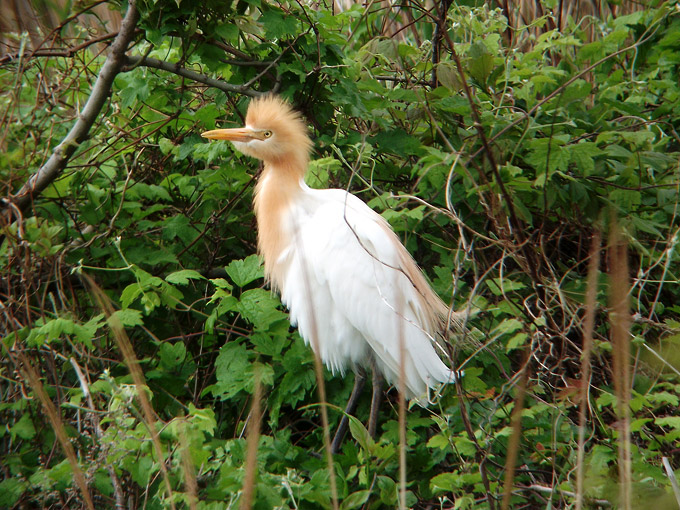
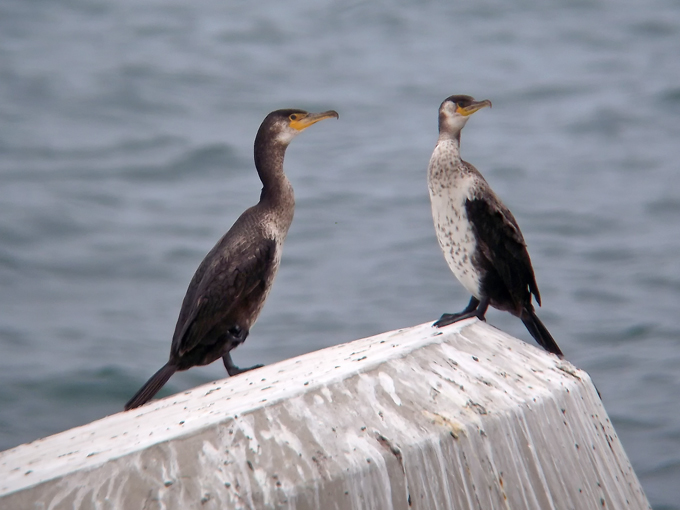
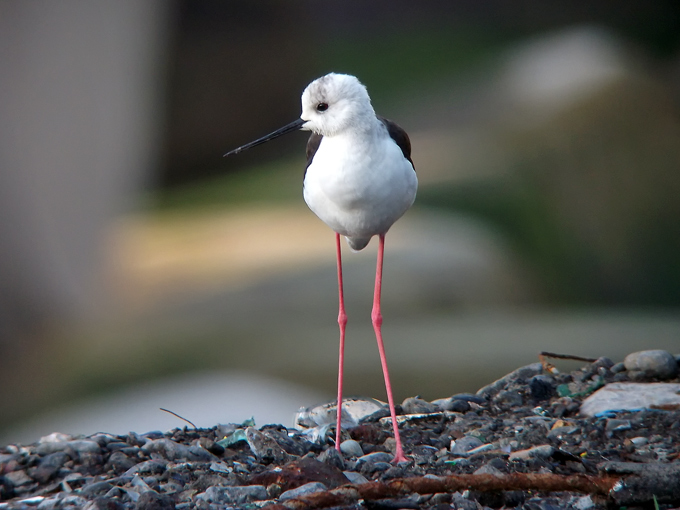



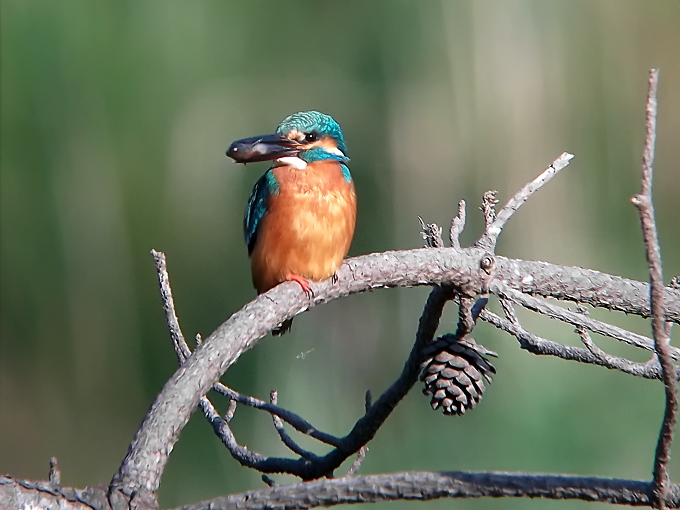
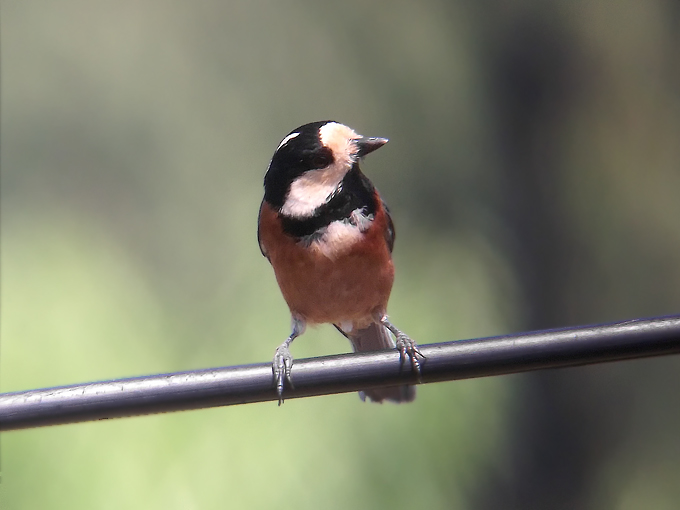


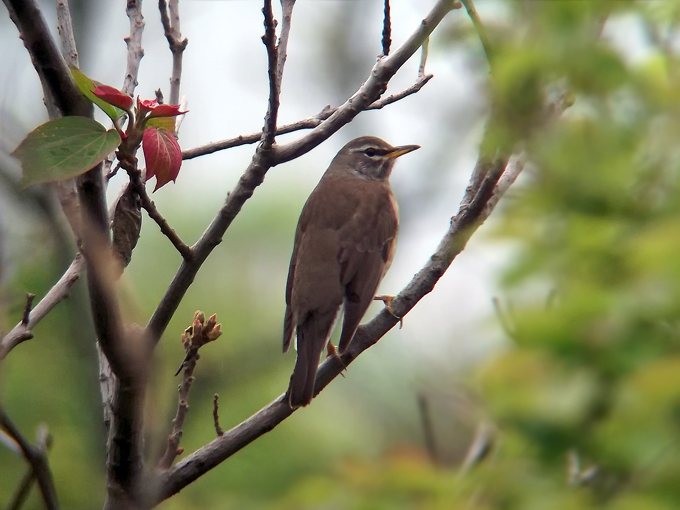
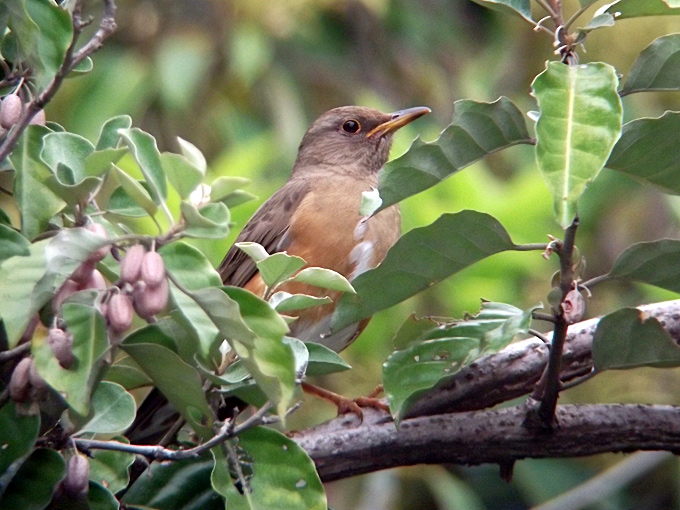

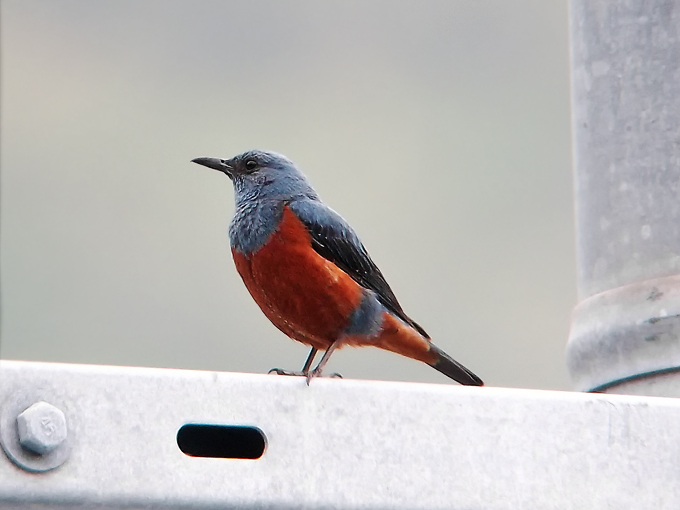
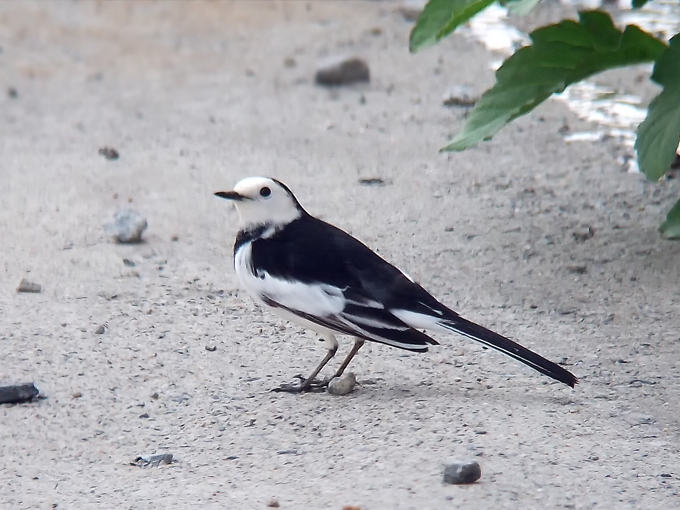
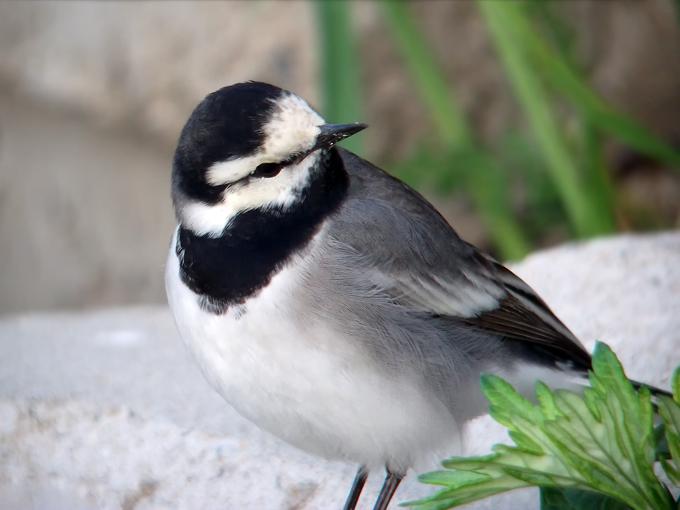
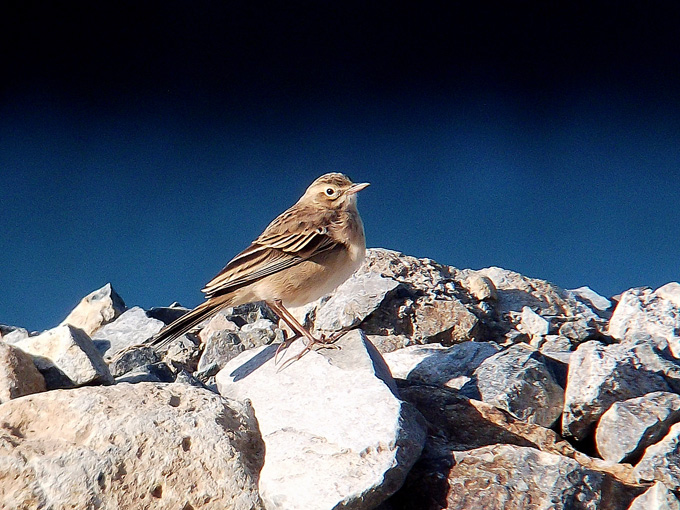
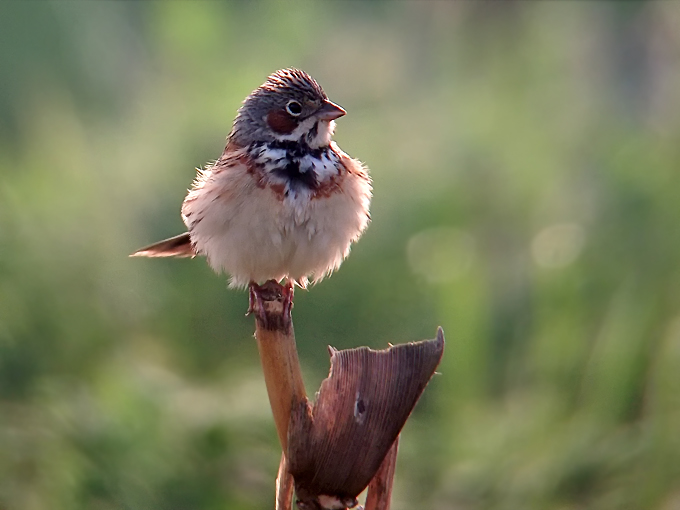

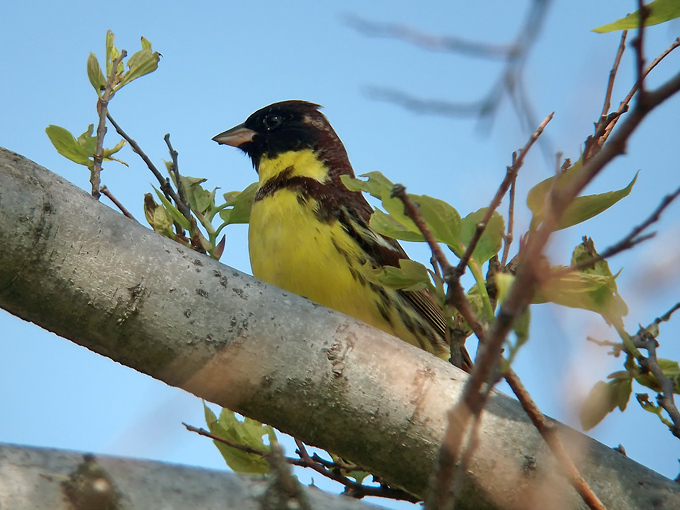
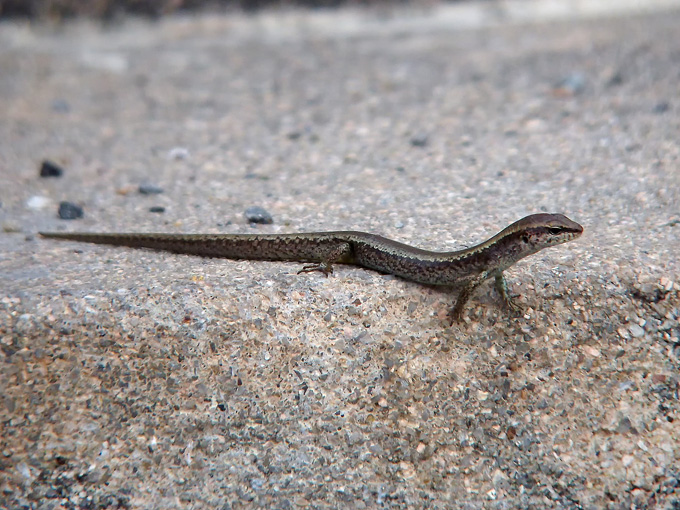
(With additional editing and layout by Birds Korea)
All observations and images by J-J. G.
Milieux
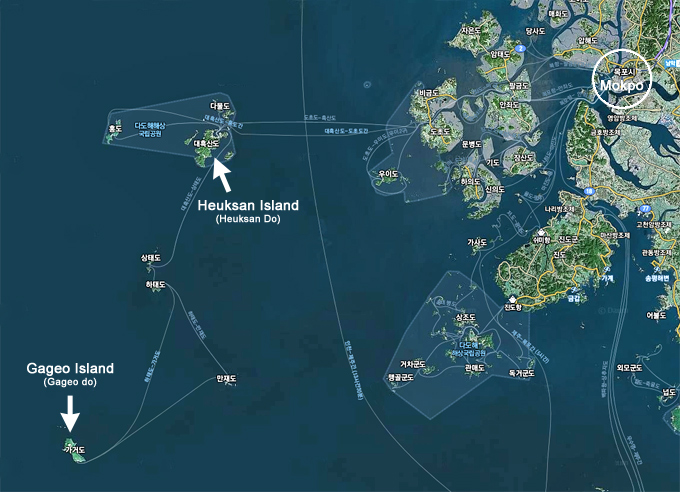
Heuk-San-Do
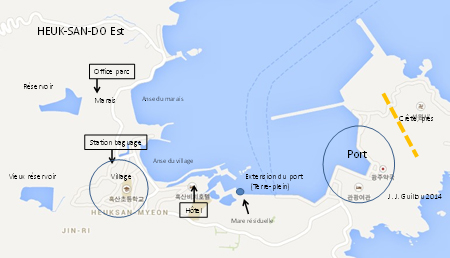
- Caldeira au nord de l’île, envahie par la mer. Tous les affleurements observés sont composés de volcanites acides aphatiniques beige pâle. Des tufs soudés, qui sont peut-être d’origine locale, sont visibles en enrochement à l’anse du marais.
- sols acides, avec Pteris aquilina et conifères
- flore très riche, couvert forestier à conifères dominants, mais mélangés de feuillus décidus et à feuillage persistant (donc de type laurisylve), sylviculture (?) de magnolias, localement prairies sur la crête (pâtures à vaches), jardins en fond de vallée (village) et sur pente (port).
- ruisseaux bétonnés, deux réservoirs dont un en fonctionnement, marais à phragmites en fond de vallée, l’un dû à une digue qui a coupé une anse (anse du marais), l’autre au village, de même origine.
- estran vaseux avec rochers et secteurs à galets. Mare résiduelle avec crabes style crabe de mangrove. Côte à marée.
- beaucoup de remblaiements sur la côte et aquaculture, pour algues et invertébrés …

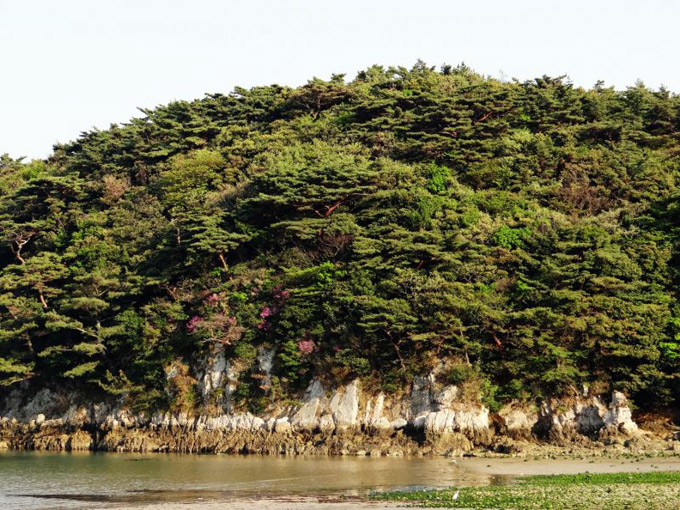
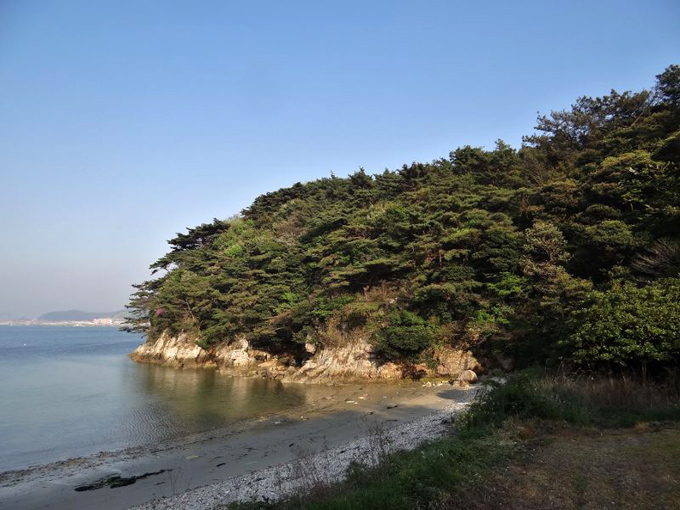
Gageo-Do
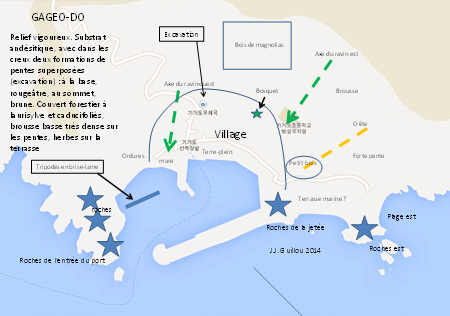
Port au sud de l’île, protégé par une énorme digue.
- Le secteur du «Petit bois» serait à préserver et ses arbres (feuillus) à multiplier: ils attirent le pigeon noir et beaucoup de migrateurs qui s’y alimentent (gros-becs, étourneaux …).
- Le manque de milieux d’eau douce est dramatique, en particulier pour les limicoles migrateurs. Il faudrait aménager la mare au débouché du ravin ouest, ce qui est possible à peu de frais.
A noter l’importance des travaux de protection du port: digue de 8m au-dessus du quai!
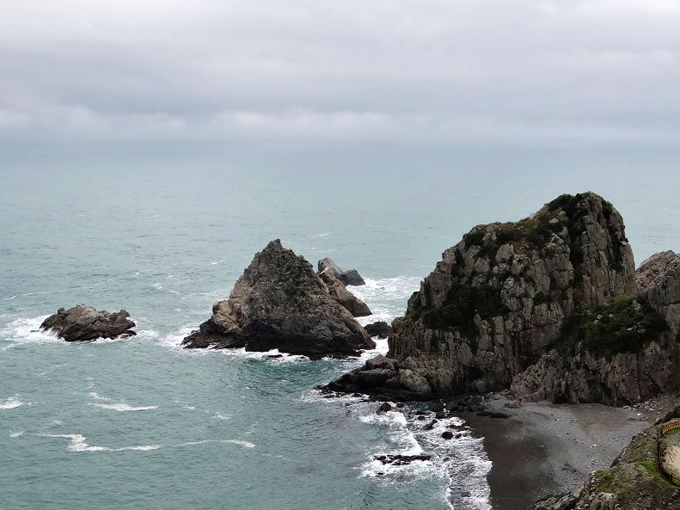

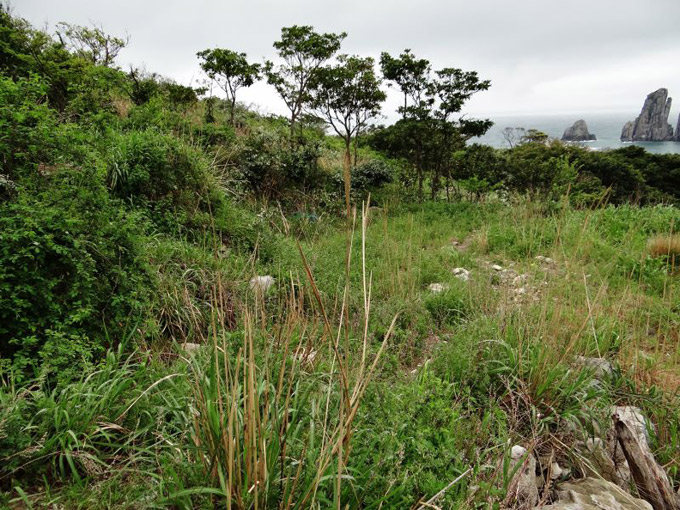
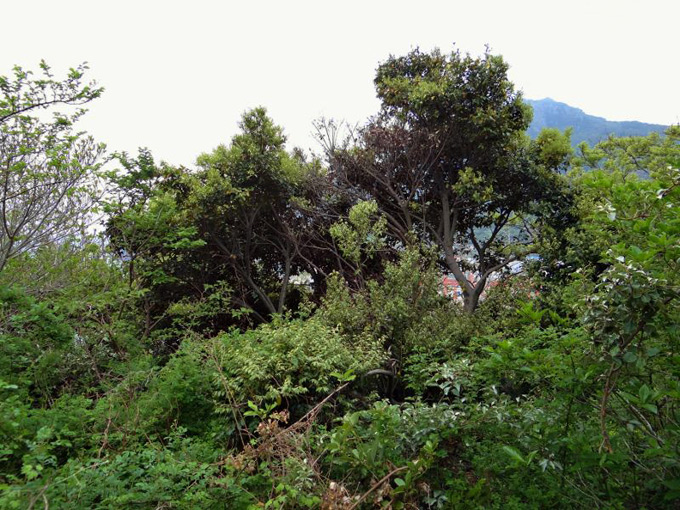

Liste
- Canard chipeau / Gadwall Anas strepera.
Le 2 mai, port de Mokpo, ordre de 10. - Canard siffleur / Eurasian Wigeon Anas penelope.
Le 2 mai, port de Mokpo, ordre de 10. - Canard de Chine / Eastern Spot-billed Duck Anas zonorhyncha.
19/4 Incheon-Mokpo. 20/4 Heuk-San-do après-midi,2+3. 21/4 Heuk-San-do, réservoir et côte. Le 21/4 Heuk-San-do après-midi, plusieurs. Le 22 matin Heuk- San-do, 2. Le 22 après-midi Heuk- San-do, 9. Le 23 matin Heuk-San-Do, quelques-uns. Le 24 après-midi Heuk-San-Do, 1. Le 30 Heuk-San-Do, noté. Le 1°mai, Heuk-San-Do, 4-5. Le 2 mai, port de Mokpo, ordre de 20. - Canard souchet / Northern Shoveler Anas clypeata.
Le 2 mai, port de Mokpo, ordre de 10. - Sarcelle d’hiver / Eurasian Teal Anas crecca.
21/4 Heuk-San-do, 1 femelle au marais. Le 22 matin Heuk- San-do, 1. Le 23 matin Heuk-San-Do, 1, probablement toujours la même. - Fuligule milouin / Common Pochard Aythya ferina.
Le 2 mai, entre Mokpo et Incheon. - Caille du Japon / Japanese Quail Coturnix japonica.
Le 25 Gageo-Do. Brousses sur la pente du haut du ravin est. Le 26 Gageo-Do, 1 sur le bord du sentier en haut du ravin est. Le 28 (pluie) Gageo-Do, 1 puis 2, envol avec un cri particulier, tout à fait différent de celui de la caille d’Europe. Tous les oiseaux toujours dans le même secteur tout en haut du ravin est, sur les bords du sentier, près de la limite des nuages (les pentes situées plus haut n’ont pas été explorées). - Plongeon arctique / Arctic Loon Gavia arctica.
Le 25/4, ferry d’Heuk-San-Do à Gageo-Do et Gageo-Do : 2 fois 2 plongeons arctiques en mer, dont une fois à l’aplomb d’un haut fond (bouées). Le 26 Gageo-Do, 1 dans le port, plumage d’hiver (photos). Le 29 (temps gris) Gageo-Do, 1 dans le port en mue.(photos)
La mer jaune, avec ses petits fonds (44m de profondeur moyenne), doit parfaitement convenir à cette espèce. - Grèbe castagneux / Little Grebe Tachybaptus ruficollis.
21/4 Heuk-San-do, 3 sur le réservoir. Le 27 (pluie) Gageo-Do, 1 dans le port. - Grèbe huppé / Great Crested Grebe Podiceps cristatus.
20/4 Heuk- San-do après-midi, 2 au port. Le 22 matin Heuk- San-do, 2. Le 22 après-midi, Heuk- San-do, 2.Le 23 matin Heuk-San-Do, 1. Le 24 après-midi Heuk-San-Do, 1. Le 25 trajet d’Heuk-San-Do à Gageo-Do et Gageo-Do. A Heuk-San et Gageo dans les ports. Le 26 Gageo-Do, 4 dans le port, 1 en mer. Le 27 (pluie) Gageo-Do, quelques-uns dans le port. Le 28 (pluie) Gageo-Do. Le 29 (temps gris) Gageo-Do, 3 au moins dans le port. Le 30 Gageo-Do, 3+1 port.
Hivernage classique en eau salée. - Petite Spatule / Black-faced Spoonbill Platalea minor.
19/4 Incheon-Mokpo. Au vol de la vasière côté continent au sud du viaduc d’Inchéon. Petite, moins élancée, en particulier le cou plus épais (dans le cas présent peu étiré) - Bihoreau gris / Black-crowned Night Heron Nycticorax nycticorax.
Le 24 après-midi Heuk-San-Do, 1 au marais. Le 29 (temps gris) Gageo-Do, 1 juvénile dans la mare à l’ouest du port. - Héron strié / Striated Heron Butorides striata.
Le 30 Gageo-Do. Posé sur un tripode à l’entrée du port de Gageo, le matin. Photo. - Crabier chinois / Chinese Pond Heron Ardeola bacchus.
Le 23 matin Heuk-San-Do, 3 petits hérons en migration. Le 28 (pluie) Gageo-Do, 1 descend en spirale pour se poser. Le 29 (temps gris) Gageo-Do, 1 en plumage nuptial dans les jardins. Très bien vu au vol de dessus. - Garde-bœufs d’Asie / Eastern Cattle Egret Bubulcus coromandus.
Le 28 (pluie) Gageo-Do, noté, plumage nuptial. Le 29 (temps gris) Gageo-Do, 31 hérons blancs ont dormi dans les arbres dans la partie ouest du village. Le 30 Gageo-Do, noté. Le 30 Heuk-San-Do, noté. Le 1°mai, Heuk-San-Do, plusieurs. - Héron cendré / Grey Heron Ardea cinerea.
19/4 Incheon-Mokpo, 2. 20/4 Heuk- San-do après-midi, 2. 21/4 Heuk-San-do,3 posés dans les pins au-dessus du réservoir. Le 22 matin Heuk-San-do, 6 au réservoir. Le 22 après-midi Heuk- San-do, quelques -uns. Le 23 matin Heuk-San-Do, 9 dans le secteur du marais. Le 24 après-midi Heuk-San-Do, 1 déjà vu hier (aile abimée). Le 25 matin Heuk-San-Do. Arrivée de 4 oiseaux. Le 26 Gageo-Do, 10 se reposent dans la journée. Le 28 (pluie) Gageo-Do. Le 29 (temps gris) Gageo-Do, présent, avec passages de petits groupes. Le 30 Gageo-Do, noté. Le 1°mai, Heuk-San-Do, plusieurs au réservoir. Le 2 mai, port de Mokpo. Le 2 mai, trajet Mokpo-Incheon, quelques-uns. - Grande Aigrette / Great Egret Ardea alba.
19/4 Incheon-Mokpo. Le 22 après-midi Heuk-San-do, 6. Le 23 matin Heuk-San-Do, 2+. Le 24 matin Heuk-San-Do, 1. Le 24 après-midi Heuk-San-Do, quelques-unes. Le 25 Gageo-Do. Le 26 Gageo-Do, 1. Le 28 (pluie) Gageo-Do, 1 passe au vol. Le 29 (temps gris) Gageo-Do, 31 hérons blancs ont dormi dans les arbres dans la partie ouest du village. Le 30 Gageo-Do, notée. Le 30 Heuk-San-Do, notée. Le 1°mai, Heuk-San-Do. - Aigrette intermédiaire / Intermediate Egret Egretta intermedia.
19/4 Incheon-Mokpo.20/4 Heuk-San-do après-midi, 1+3.. 21/4 Heuk-San-do, un peu partout. Le 21/4 Heuk-San-do après-midi, plusieurs. Le 22 matin Heuk- San-do, plus de 6. Le 22 après-midi Heuk- San-do, notée. Le 23 matin Heuk-San-Do, 10 au moins. Le 23 après-midi, Heuk-San-Do crête, notée. Le 24 matin Heuk-San-Do, 1. Le 24 après-midi Heuk-San-Do, 10+. Le 25 matin Heuk-San-Do. Sur la côte, 1+. Le 25 Gageo-Do. Le 26 Gageo-Do. Le 27 (pluie) Gageo-Do. Le 28 (pluie) Gageo-Do, 3 passent et 1 à 2 stationnent. Le 29 (temps gris) Gageo-Do, 31 hérons blancs ont dormi ensemble dans les arbres dans la partie ouest du village. Le 30 Gageo-Do, notée. Le 30 Heuk-San-Do, notée. Le 1°mai, Heuk-San-Do. Le 2 mai, trajet Mokpo-Incheon, quelques-unes (et grandes aigrettes?). - Aigrette garzette / Little Egret Egretta garzetta.
19/4 Incheon-Mokpo. Le 22 matin Heuk- San-do, 1. Le 22 après-midi Heuk- San-do, 1. Le 23 matin Heuk-San-Do, 1. Le 29 (temps gris) Gageo-Do, 31 hérons blancs ont dormi dans les arbres dans la partie ouest du village. Le 30 Heuk-San-Do, notée. - Cormoran pélagique / Pelagic Cormorant Phalacrocorax pelagicus.
Le 27 (pluie) Gageo-Do, 1 dans le port. Le 30 Gageo-Do, 1 sur les tripodes du port, ailes ouvertes. - Grand Cormoran / Great Cormorant Phalacrocorax carbo.
Le 2 mai, port de Mokpo (avec Andreas), oiseau perché sur une embarcation, la distribution des parties colorées et nues de sa face, étant différente de celle du Temminck. - Cormoran de Temminck / Temminck’s Cormorant Phalacrocorax capillatus.
21/4 Heuk-San-do, 1 dans le port. Le 22 après-midi Heuk- San-do, 1 dans le port. Le 25, trajet d’Heuk-San-Do à Gageo-Do et Gageo-Do. Port d’Heuk-San et nicheurs en petit nombre sur une falaise près d’une île où on a fait escale. Le 26 Gageo-Do, 1 dans le port puis 7-8. Le 27 (pluie) Gageo-Do, 2 dans le port. Le 28 (pluie) Gageo-Do, longuement observé posé dans le port: non nuptial, comme tous les oiseaux bien vus. Le 29 (temps gris) Gageo-Do, 2 au moins dans le port. Le 30 Gageo-Do, 1 dans le port.
Donc peau nue nettement moins étendue que chez le grand cormoran, surtout sous le bec. - Epervier de Chine / Chinese Sparrowhawk Accipiter soloensis.
Le 29 (temps gris) Gageo-Do, 1 mâle posé à l’affut en haut d’un arbuste du petit bois, très longuement observé. La cire du bec de cet individu était d’un jaune très vif, remarquable. - Epervier du Japon / Japanese Sparrowhawk Accipiter gularis.
Le 23 matin Heuk-San-Do, 1 épervier de très petite taille (tourterelle) dans le village, part dans les bois. Le 24 matin Heuk-San-Do, 1 probable. Le 28 (pluie) Gageo-Do, un mâle minuscule (cf. taille d’une petite tourterelle) au petit bois. - Milan noir / Black Kite Milvus migrans.
Le 22 matin Heuk- San-do, 1 survole le réservoir. - Pygargue à queue blanche / White-tailed Eagle Haliaeetus albicilla.
Le 23 matin Heuk-San-Do, 1 subadulte très haut dans le ciel. - Busautour à joues grises / Grey-faced Buzzard Butastur indicus.
Le 20/4 Heuk-San-Do après-midi, 1. Le 1°mai, Heuk-San-Do, 3 en vol de migration, plus ou moins hautes, une se pose. - Buse du Japon / Eastern Buzzard Buteo japonicus.
Le 26 Gageo-Do, 1 vue de dessus survolant le village, ailes très marquées. Le 30 Gageo-Do, vue à deux reprises. - Faucon hobereau / Eurasian Hobby Falco subbuteo.
Le 29 (temps gris) Gageo-Do, 1 au-dessus du petit bois. - Faucon pèlerin / Peregrine Falcon Falco peregrinus.
Le 20/4 Heuk-San-Do après-midi, un couple. Le 21/4 Heuk-San-do, en vol au-dessus des collines. Le 21/4 Heuk-San-do après-midi, 1 mâle. Le 23 matin Heuk-San-Do, 1. Le 28 (pluie) Gageo-Do, 1 mâle. Le 29 (temps gris) Gageo-Do, un couple joue au-dessus de la terrasse, grande taille- Le 1°mai, Heuk-San-Do, 1 mâle. - Faucon crécerelle / Common Kestrel Falco tinnunculus.
Le 2 mai, Mokpo, 1. - Gallinule poule-d’eau / Common Moorhen Gallinula chloropus.
Le 24 après-midi Heuk-San-Do, 1 au marais, revue. Le 1°mai, Heuk-San-Do, une vue et entendue au marais. (photo d’une morte, trouvée face à la station de baguage du «1°») - Huîtrier pie / Far Eastern Oystercatcher Haematopus ostralegus.
Le 20/4 Heuk-San-do, sur le trajet posé sur une île, 1 puis sans doute encore 2. - Echasse blanche / Black-winged Stilt Himantopus himantopus.
Le 29 (temps gris) Gageo-Do, une paire (mâle-femelle) posée sur la mare, ils vont rester là toute la journée. Le 30 Gageo-Do, les 2. - Pluvier fauve / Pacific Golden Plover Pluvialis fulva.
Le 28 (pluie) Gageo-Do, 1 possible le matin sur la terrasse marine à l’envol. Le 28 (pluie) Gageo-Do, après-midi, 1 (photo). Le 1°mai, Heuk-San-Do, une troupe posée sur une prairie à vaches sur la crête au-dessus du port avec deux courlis nains. - Pluvier argenté / Grey Plover Pluvialis squatarola.
Le 2 mai, port de Mokpo, une dizaine. - Gravelot à collier interrompu / Kentish Plover Charadrius alexandrinus.
Le 2 mai, port de Mokpo, une douzaine sur l’estran vaseux. - Gravelot mongol / Mongolian Plover Charadrius mongolus.
Le 30 Heuk-San-Do, 2+1 sur l’estran à marée basse. - Bécassine à queue pointue / Pin-tailed Snipe Gallinago stenura.
Le 21/4 Heuk-San-do après-midi, 1 d’espèce indéterminée. Le 22 au matin Heuk- San-Do, 2 au marais, dont une pousse un cri doux, vol direct et court. Le 25 Gageo-Do, 1 posée à mes pieds à 2m du sentier, cachée la tête dans l’herbe. Après quelques secondes elle redresse la tête, me regarde puis elle s’envole sur 10m pour rentrer à la base d’arbrisseaux. Le 29 (temps gris) Gageo-Do, 1. - Barge à queue noire orientale / Black-tailed Godwit Limosa limosa melanuroides.
Le 2 mai, port de Mokpo, 1 en plumage nuptial. - Barge rousse / Bar-tailed Godwit Limosa lapponica.
Le 2 mai, port de Mokpo, quelques dizaines en plumage nuptial. - Courlis nain / Little Curlew Numenius minutus.
Le 29 (temps gris) Gageo-Do, sur le terre-plein à l’envol, vol très puisant, cri trissylabique. Le 1°mai, Heuk-San-Do, 2 posés sur une prairie à vaches sur la crête au-dessus du port, avec des pluviers fauves. Port de tête très droit, rigide. Sourcil très marqué, plus que chez le corlieu. Petite taille, surtout si l’on remarque que le pluvier fauve est nettement plus petit que le pluvier doré. Envol à l’arrivée d’un vacher, volent pratiquement en queue de groupe avec les pluviers, avec le même coup d’aile puissant. - Courlis corlieu / Whimbrel Numenius phaeopus.
Le 23 matin Heuk-San-Do, 1 dans l’anse du village. Le 2 mai, port de Mokpo, des dizaines. - Courlis cendré / Eurasian Curlew Numenius arquata.
Le 2 mai, Incheon, au vol. - Chevalier gambette / Common Redshank Tringa totanus.
Le 30 Heuk-San-Do, 2 à l’anse du marais. - Chevalier stagnatile / Marsh Sandpiper Tringa stagnatilis.
Le 23 matin Heuk-San-Do, 1 au marais. Le 28 (pluie) Gageo-Do, 1. Le 29 (temps gris) Gageo-Do, 1 probable. Le 30 Gageo-Do, 2. - Chevalier aboyeur / Common Greenshank Tringa nebularia.
Le 20/4 Heuk-San-Do après-midi, 1 plage anse village. Le 21/4 Heuk-San-do après-midi, 1 sur la côte. Le 22 après-midi Heuk- San-do, 1. Le 23 matin Heuk-San-Do, 1+1.. Le 23 après-midi, Heuk-San-Do entendu. Le 24 après-midi Heuk-San-Do, 1anse du marais. Le 25 matin Heuk-San-Do. 2 sur la côte. Le 28 (pluie) Gageo-Do, 1 au port. Le 29 (temps gris) Gageo-Do, sur la mare. Le 30 Gageo-Do, 1 et 3. Le 30 Heuk-San-Do. Le 1°mai, Heuk-San-Do. Le 2 mai, port de Mokpo, 2+. - Chevalier cul-blanc / Green Sandpiper Tringa ochropus.
Le 20/4 Heuk-San-Do après-midi, 1+1. Le 21/4 Heuk-San-do, 1 au marais. Le 24 après-midi Heuk-San-Do, 1. Le 26 Gageo-Do, 1 sur la prairie de la terrasse. Le 29 (temps gris) Gageo-Do, quelques-uns. Le 30 Gageo-Do, plusieurs. Le 1°mai, Heuk-San-Do. - Chevalier sylvain / Wood Sandpiper Tringa glareola.
Le 21/4 Heuk-San-do, 3 au marais. Le 22 matin Heuk- San-do, 1 au village, 3 au marais. Le 22 après-midi Heuk- San-do, 2. Le 23 matin Heuk-San-Do, 3-4 au marais. Le 24 après-midi Heuk-San-Do, 1 et 1. Le 28 (pluie) Gageo-Do, noté. Le 29 (temps gris) Gageo-Do, plusieurs. Le 30 Gageo-Do, plusieurs. Le 30 Heuk-San-Do. Le 1°mai, Heuk-San-Do. - Chevalier de Sibérie / Grey-tailed Tattler Tringa brevipes.
Le 29 (temps gris) Gageo-Do, sur la mare. Le 30 Gageo-Do, 1. Le 30 Heuk-San-Do. Le 2 mai, port de Mokpo, au moins 2. - Chevalier bargette / Terek Sandpiper Xenus cinereus.
Le 28 (pluie) Gageo-Do, 1 au port. Le 29 (temps gris) Gageo-Do, sur la mare. Le 30 Gageo-Do, 1. Le 2 mai, port de Mokpo, quelques-uns. - Chevalier guignette / Common Sandpiper Actitis hypoleucos.
Le 21/4 Heuk-San-do, côte. Le 22 matin Heuk- San-do, 2. Le 22 après-midi Heuk- San-do, 3+1. Le 24 après-midi Heuk-San-Do, 1. Le 25 matin Heuk-San-Do. Notée. Le 28 (pluie) Gageo-Do, 2. Le 29 (temps gris) Gageo-Do, plusieurs. Le 30 Gageo-Do, peu. Le 30 Heuk-San-Do, notée. Le 1°mai, Heuk-San-Do. Le 2 mai, port de Mokpo, quelques-uns. - Tournepierre à collier / Ruddy Turnstone Arenaria interpres.
Le 2 mai, port de Mokpo, plusieurs dizaines. - Bécasseau à cou roux / Red-necked Stint Calidris ruficollis.
Le 28 (pluie) Gageo-Do, noté l’après-midi, 2 dont un nuptial. Le 29 (temps gris) Gageo-Do, plusieurs. Le 30 Gageo-Do, 2-3. Le 2 mai, port de Mokpo, 6 et 1. - Bécasseau de Temminck / Temminck's Stint Calidris temminckii.
Le 29 (temps gris) Gageo-Do, 1 en plumage nuptial. Le 30 Gageo-Do, 1 sur les tripodes (couverture d’algues vertes). - Bécasseau à longs doigts / Long-toed Stint Calidris subminuta.
Le 22 après-midi, Heuk- San-do, 1 sur la mare résiduelle du port. Le 30 Gageo-Do, 2 sur les tripodes. Le 30 Heuk-San-Do, noté. - Bécasseau à queue pointue / Sharp-tailed Sandpiper Calidris acuminata.
Le 30 Gageo-Do, aperçu. - Bécasseau variable / Dunlin Calidris alpina.
Le 30 Gageo-Do, 1 nuptial. Le 2 mai, port de Mokpo. - Combattant varié / Ruff Philomachus pugnax.
Le 29 (temps gris) Gageo-Do, une femelle posée sur la mare puis sur les tripodes (couvert d’algues vertes). - Mouette rieuse / Black-headed Gull Chroicocephalus ridibundus.
19/4 Incheon-Mokpo. Une à Incheon. Le 2 mai, port de Mokpo, 1. - Goéland à queue noire / Black-tailed Gull Larus crassirostris.
19/4 Incheon-Mokpo. Le 20/4 Heuk-San-Do après-midi. Le 23 matin Heuk-San-Do, 1 dans l’anse du village. Le 24 après-midi Heuk-San-Do, 1. Le 25 trajet d’Heuk-San-Do à Gageo-Do et Gageo-Do. Le 26 Gageo-Do, 1 au port. Le 28 (pluie) Gageo-Do, noté dans les goélands présents sur les tripodes. Le 30 Gageo-Do, noté. Le 2 mai, port de Mokpo. - Goéland de la Véga / Vega Gull Larus vegae (et Goéland de Mongolie Larus mongolicus?).
Le 20/4 Heuk-San-Do après-midi, dont un à pieds jaunes. Le 21/4 Heuk-San-do.. Le 21/4 Heuk-San-do, dans le port, secteur extension est. Le 22 matin Heuk- San-do, 1 blessé. Le 22 après-midi Heuk- San-do, 2 aux pattes jaunes, 10 aux pattes roses dont l’un aux tarses pâles. Le 23 matin Heuk-San-Do, le blessé.. Le 23 après-midi, Heuk-San-Do port, toujours quelques pieds jaunes. Le 24 matin Heuk-San-Do, photos. Le 24 après-midi Heuk-San-Do. Le 25 trajet d’Heuk-San-Do à Gageo-Do et Gageo-Do. Le 26 Gageo-Do, 20 au port. Le 28 (pluie) Gageo-Do. Le 30 Gageo-Do, noté. Le 30 Heuk-San-Do, species. Le 1°mai, Heuk-San-Do, idem. - Goéland à manteau ardoisé / Slaty-backed Gull Larus schistisagus.
Le 20/4 Heuk-San-Do après-midi, un possible. - Sterne naine / Little Tern Sternula albifrons.
Le 2 mai, port de Mokpo. - Macareux rhinocéros / Rhinoceros Auklet Cerorhinca monocerata.
20/4 trajet Mokpo à Heuk-San, en mer, 18 +3. Au vol: taille assez grande, vol de grand alcidé, bec court, tout noir à très sombre. - Pigeon noir / Japanese Wood Pigeon Columba janthina.
Le 22 matin Heuk- San-do, 1 probable dans les arbres près de l’office du parc. Le 26 Gageo-Do, 1 vu passant à20m au petit bois, arrivant de quelque part au-dessus du village. Revu dans la journée, même lieu. Le 29 (temps gris) Gageo-Do, vu 2 fois au petit bois. Le 30 Gageo-Do, un individu se pose à quelques mètres de nous à mi-hauteur dans le petit bois et reste là une bonne minute; plumage gris très foncé et non franchement noir. - Tourterelle orientale / Oriental Turtle Dove Streptopelia orientalis.
19/4 trajet Incheon-Mokpo. Le 20/4 Heuk-San-Do après-midi. Le 21/4 Heuk-San-do. Le 21/4 Heuk-San-do après-midi. Le 22 matin Heuk- San-do, 2. Le 22 après-midi Heuk- San-do, notée. Le 23 matin Heuk-San-Do, notée. Le 23 après-midi, Heuk-San-Do, commune. Le 24 après-midi Heuk-San-Do, notée. Le 25 matin Heuk-San-Do. Quelques-unes. Le 30 Heuk-San-Do, notée. Le 1°mai, Heuk-San-Do. Le 2 mai, port de Mokpo. - Pigeon biset / Feral Pigeon Columba livia.
Le 21/4, Heuk-San-do après-midi, 1 (pigeon voyageur avec une bague, revu). - Coucou oriental / Oriental Cuckoo Cuculus optatus.
Le 24 après-midi Heuk-San-Do. Entendu. - Salangane de l’Himalaya / Himalayan Swiftlet Aerodramus brevirostris.
Le 21/4 Heuk-San-do, au-dessus du réservoir, salangane typique, supposée être brevirostris, ce qui est vraisemblable. Le 22 après-midi Heuk- San-do, revue, sans doute le même oiseau, volant au-dessus de la station de baguage. - Martinet de Sibérie / Pacific Swift Apus pacificus.
Le 23 matin Heuk-San-Do, 1 au-dessus du marais. Le 23 après-midi, Heuk-San-Do crête, 1. Le 24 matin Heuk-San-Do, 1 à 9h45. Le 1°mai, Heuk-San-Do, 2 à la crête. - Martin-pêcheur d’Europe / Common Kingfisher Alcedo atthis.
Le 21/4 Heuk-San-do, dans le marigot du village. Le 28 (pluie) Gageo-Do, 1. Le 29 (temps gris) Gageo-Do, perché sur un fil dans une rue du village. Le 30 Gageo-Do, noté. - Minivet cendré / Ashy Minivet Pericrocotus divaricatus.
Le 21/4 Heuk-San-do, 1 en vol. - Pie-grièche bucéphale / Bull-headed Shrike Lanius bucephalus.
Le 23 après-midi, Heuk-San-Do crête, en haut du village, une nichée avec au moins deux petits (trois?), nourrit par le mâle et la femelle. Proie: petit serpent ou grand ver. Le 24 matin Heuk-San-Do, 1 femelle bien vue. - Tchitrec du Japon, Terpsiphone atrocaudata.
Le 30 Gageo-Do, vu longuement de très près. Plumage de femelle. Brun du dos caractéristique. Posé au-dessus du petit ravin est, secteur humide à ordures. - Pie bavarde / Eurasian Magpie Pica pica.
19/4 Incheon-Mokpo, plusieurs. Le 2 mai, Mokpo et trajet Mokpo-Incheon. - Corneille noire / Carrion Crow Corvus corone.
Le 3 mai, Incheon. - Mésange variée / Varied Tit Sittiparus varius.
Le 20/4 Heuk-San-Do après-midi: notée. Le 21/4 Heuk-San-do, au marais. Le 22 matin Heuk- San-do, plusieurs contacts vers le marais, posée dans les pins, les saules, les fils électriques... Le 23 matin Heuk-San-Do, une mésange du côté du marais, sur des buissons secs; puis elle cherche à nicher explorant le haut d’un pylone. Le 24 matin Heuk-San-Do, 3. Le 25 matin Heuk-San-Do, 2 contacts. Le 1°mai, Heuk-San-Do, village. - Mésange de Chine / Japanese Tit Parus minor.
Le 21/4 Heuk-San-do, 2. Le 22 matin Heuk- San-do, 1 au marais. Le 23 matin Heuk-San-Do, 1. Le 24 matin Heuk-San-Do, 2. Le 24 après-midi Heuk-San-Do, notée. Le 25 matin Heuk-San-Do, 3 contacts. Le 1°mai, Heuk-San-Do. - Bulbul de Chine / Light-vented Bulbul Pycnonotus sinensis.
Le 20/4 Heuk-San-Do après-midi: 1. Le 21/4 Heuk-San-do, entendu. Le 22 matin Heuk- San-do, 2 au moins.. Le 23 après-midi, Heuk-San-Do crête, 3+. Le 24 matin Heuk-San-Do, 3. Le 25 Gageo-Do, 2. Le 26 Gageo-Do, entendu puis vu le soir. Le 27 (pluie) Gageo-Do, 2. Le 28 (pluie) Gageo-Do, noté. Le 29 (temps gris) Gageo-Do, 1 chanteur. Le 30 Gageo-Do, entendu. Le 1°mai, Heuk-San-Do. - Bulbul à oreillons bruns / Brown-eared Bulbul Hypsipetes amaurotis.
Le 20/4 Heuk-San-Do après-midi: très commun. Le 21/4 Heuk-San-do, très commun, id après-midi. Le 22 matin Heuk- San-do, beaucoup. Le 22 après-midi Heuk- San-do. -Le 23 matin Heuk-San-Do, très commun. Le 23 après-midi, Heuk-San-Do crête, noté. Le 24 matin Heuk-San-Do, commun. Le 24 après-midi Heuk-San-Do. Noté. Le 25 matin Heuk-San-Do. Le 25 Gageo-Do. Le 26 Gageo-Do. Le 27 (pluie) Gageo-Do, 2. Le 28 (pluie) Gageo-Do, noté. Le 29 (temps gris) Gageo-Do, plusieurs couples.. Le 30 Gageo-Do, 4-5 vers le petit bois, d’autres ailleurs. Le 30 Heuk-San-Do. Le 1°mai, Heuk-San-Do. Le 2 mai, Mokpo. - Hirondelle de rivage / Sand Martin Riparia riparia.
Le 29 (temps gris) Gageo-Do, 1. - Hirondelle rustique / Barn Swallow Hirundo rustica.
19/4 Incheon-Mokpo. Le 21/4 Heuk-San-do, petit passage. Le 21/4 Heuk-San-do après-midi, nombreuses. Le 22 matin Heuk- San-do, de l’ordre de 20. Le 23 matin Heuk-San-Do, troupe.. Le 23 après-midi, Heuk-San-Do, nombreuses, dizaines. Le 24 matin Heuk-San-Do, petit passage. Le 24 après-midi Heuk-San-Do, quelques-unes. Le 25 matin Heuk-San-Do. 20 à 7h. Le 25 Gageo-Do, quelques-unes. Le 26 Gageo-Do, aucunes puis une arrivée d’oiseaux. Le soir il commence à pleuvoir un peu et les hirondelles cherchent à se poser pour la nuit. Le 27 (pluie) Gageo-Do, nombreuses. Le 28 (pluie) Gageo-Do, présentes. Le 29 (temps gris) Gageo-Do. Le 30 Gageo-Do, dizaines. Le 1°mai, Heuk-San-Do , migration irrégulière (avec autres espèces?), parfois assez nombreuses. - Hirondelle de fenêtre / Common House Martin Delichon urbicum
Le 29 (temps gris) Gageo-Do, 1, puis oiseaux revus. - Hirondelle rousseline / Red-rumped Swallow Cecropis daurica.
Le 21/4 Heuk-San-do, 1 et 1 (+?). Le 23 matin Heuk-San-Do, 2. Le 27 (pluie) Gageo-Do, 1. Le 28 (pluie) Gageo-Do, présentes. Le 29 (temps gris) Gageo-Do. - Bouscarle chanteuse / Japanese Bush Warbler Horornis diphone.
Entendue chaque jour. Le 20/4 Heuk-San-Do après-midi: chant classique de type japonais. Le 22 matin Heuk- San-do, entendue assez souvent. Le 22 après-midi Heuk-San-Do, entendue. Le 23 au matin Heuk-San-Do, très bien observée à deux reprises, avec les deux chants: l’attaque du chant classique commence avec l’oiseau la gorge gonflée. Les deux types de chant s’enchaînent, la longue roulade arrivant en premier. Le 23 après-midi, Heuk-San-Do crête, vue. Le 24 matin Heuk-San-Do, au moins 2-3 contacts. Le 24 après-midi Heuk-San-Do, entendue. Le 25 matin Heuk-San-Do, entendu deux individus. Le 25 Gageo-Do, quelques-unes dont une bien vue. Le 26 Gageo-Do. Le 28 (pluie) Gageo-Do, notée. Le 29 (temps gris) Gageo-Do, entendu plusieurs, toutes diphone.. Le 30 Gageo-Do, entendue. Le 30 Heuk-San-Do, notée. Le 1°mai, Heuk-San-Do. - Bouscarle de Swinhoe / Asian Stubtail Urosphena squameiceps.
Le 21/4 Heuk-San-Do, 1 dans un buisson. Le 25 Gageo-Do, 1 vue sous un buisson et une revue au village. Le 26 Gageo-Do, une aperçue dans le port!- Le 28 (pluie) Gageo-Do, notée. Le 29 (temps gris) Gageo-Do, très bien vue au-dessus-du ruisseau du ravin est, à la hauteur du petit bois. Le 30 Gageo-Do, toujours là, facile à voir, cantonnée et nicheuse?. - Mésange à longue queue / Long-tailed Tit Aegithalos caudatus.
Le 21/4 Heuk-San-do, 2 contacts. Le 24 matin Heuk-San-Do, 1. - Pouillot à grands sourcils / Yellow-browed Warbler Phylloscopus inornatus.
Le 23 après-midi, Heuk-San-Do crête, 1 bien vu. Le 29 (temps gris) Gageo-Do, 1 au petit bois. - Pouillot à pattes claires / Pale-legged Leaf Warbler Phylloscopus tenellipes.
Le 30 Gageo-Do, dans le petit bois. - Pouillot type boréal Phylloscopus borealides.
Le 29 (temps gris) Gageo-Do, 1. Le 1°mai, Heuk-San-Do, avec d’autres pouillots. - Pouillot de Temminck / Eastern Crowned Warbler Phylloscopus coronatus.
Le 23 après-midi, Heuk-San-Do crête, 1. Le 30 Gageo-Do, les plus nombreux de loin. - Pouillot sp. Phylloscopus sp..
Le 21/4 Heuk-San-Do après-midi, 1.
Beaucoup de pouillots n’ont pas été déterminés avec certitude, n’étant pas repérés à l’oreille. - Pouillot type verdâtre Phylloscopus sp..
Le 30 Gageo-Do, 1. - Rousserolle d’Orient / Oriental Reed Warbler Acrocephalus orientalis.
Le 24 matin Heuk-San-Do, 1 ? (thick-billed possible). Le 28 (pluie) Gageo-Do, vue deux fois, le matin dans le ravin est, le soir dans les buissons au-dessus des ordures à l’ouest. Le 29 (temps gris) Gageo-Do, entendu le chant (faible, à mi-voix). Le 1°mai, Heuk-San-Do, chante au marais. - Zostérops du Japon / Japanese White-eye Zosterops japonicus.
Le 20/4 Heuk-San-Do après-midi: 2. Le 21/4 Heuk-San-do après-midi. Le 22 matin Heuk- San-do, un couple construit vers le marais, l’un des oiseaux a un bout de feuille au bec. Le 23 matin Heuk-San-Do, 6+. Le 23 après-midi, Heuk-San-Do crête, 6 à 8 au moins. Le 24 matin Heuk-San-Do, plusieurs contacts. Le 26 Gageo-Do, quelques-uns. Le 29 (temps gris) Gageo-Do, 2-3 contacts. Le 30 Gageo-Do, 1 collecte deux fois de la soie d’un cocon dans un arbre au-dessus du petit ravin humide à ordures: nicheur très probable en train de garnir son nid. Le 1°mai, Heuk-San-Do. - Etourneau gris / White-cheeked Starling Spodiopsar cineraceus.
Le 23 après-midi, Heuk-San-Do crête, un petit vol, 1 posé sur la prairie. Le 24 matin Heuk-San-Do, 2 perchés sur un fil. Le 29 (temps gris) Gageo-Do, devant l’hôtel. Le 30 Heuk-San-Do. - Etourneau de Daourie / Daurian Starling Agropsar sturninus.
Le 25 matin Heuk-San-Do. 2. - Etourneau à joues marron / Chestnut-cheeked Starling Agropsar philippensis.
Le 26 Gageo-Do, 4-5 dans le haut des arbres du petit bois. Le 28 (pluie) Gageo-Do, noté. Le 1°mai, Heuk-San-Do, 30. - Etourneau mandarin / White-shouldered Starling Sturnia sinensis.
Le 28 (pluie) Gageo-Do, noté. - Merle à dos gris / Grey-backed Thrush Turdus hortulorum.
Le 21/4 Heuk-San-do, un mâle bien vu et 1 couple. Le 23 après-midi, Heuk-San-Do crête, aperçu. Le 24 matin Heuk-San-Do, 1 mâle. Le 1°mai, Heuk-San-Do, 1. - Merle du Japon / Japanese Thrush Turdus cardis.
Le 24 matin, Heuk-San-Do, 1 femelle dans la forêt. - Grive obscure / Eyebrowed Thrush Turdus obscurus.
Le 20/4 Heuk-San-Do après-midi: 1 mâle. Le 23 matin Heuk-San-Do, 1 mâle. Le 28 (pluie) Gageo-Do, noté. Le 29 (temps gris) Gageo-Do, secteur du bois de magnolia. - Merle pâle / Pale Thrush Turdus pallidus.
Le 20/4 Heuk-San-Do après-midi: très commun. Le 21/4 Heuk-San-do, commun à très commun, id après-midi. Le 22 matin Heuk- San-do, nombreux. Le 22 après-midi Heuk- San-do, vu de près. Le 23 matin Heuk-San-Do, commun. Le 23 après-midi, Heuk-San-Do crête, commun. Le 24 matin Heuk-San-Do, commun. Le 24 après-midi Heuk-San-Do, noté. Le 25 matin Heuk-San-Do, quelques contacts. Le 25 Gageo-Do, 2. Le 1°mai, Heuk-San-Do. - Merle à flancs roux / Brown-headed Thrush Turdus chrysolaus.
Le 26 Gageo-Do, aperçu puis bien vu. Le 29 (temps gris) Gageo-Do, 1 bien vu (et plusieurs en vol). Le 1°mai, Heuk-San-Do, 1. - Grive à ailes rousses / Dusky Thrush Turdus eunomus.
Le 21/4 Heuk-San-do, 1. Le 21/4 Heuk-San-do après-midi, 1 très bien vue. Le 28 (pluie) Gageo-Do, notée. - Gobemouche brun / Asian Brown Flycatcher Muscicapa latirostris.
Le 20/4 Heuk-San-Do après-midi, 2. Le 21/4 Heuk-San-do, très bien vu. Le 23 après-midi, Heuk-San-Do crête, plusieurs. Le 26 Gageo-Do, 1. Le 28 (pluie) Gageo-Do, noté. Le 30 Gageo-Do, 1 paire. - Gobemouche sp.
Le 26 Gageo-Do, un oiseau sombre dessous, tout uni, pas déterminé. - Gobemouche bleu / Blue-and-white Flycatcher Cyanoptila cyanomelana.
Le 20/4 Heuk-San-Do après-midi, 1 mâle. Le 21/4 Heuk-San-do, 1 au réservoir. Le 28 (pluie) Gageo-Do, observé longuement dans le petit bosquet dans les jardins. Le 30 Gageo-Do, 1. - Rossignol bleu / Siberian Blue Robin Larvivora cyane.
Le 29 (temps gris) Gageo-Do, 1 sans queue sur la côte rocheuse (photo), 1 dans le bosquet du village, 1 dans un jardin.. Le 30 Gageo-Do, 1 dans le secteur est, dans de petits magnolias et un jardin. - Calliope de Sibérie / Siberian Rubythroat Calliope calliope.
Le 28 (pluie) Gageo-Do, un oiseau chante à demi-caché dans un petit buisson le long du sentier du ravin est. - Robin à flancs roux / Red-flanked Bluetail Tarsiger cyanurus.
Le 23 après-midi, Heuk-San-Do crête, une femelle. - Gobemouche à croupion jaune / Yellow-rumped Flycatcher Ficedula zanthopygia.
Le 23 après-midi, Heuk-San-Do crête, mâle posé, très bien vu. - Gobemouche narcisse / Narcissus Flycatcher Ficedula narcissina.
Le 21/4 Heuk-San-do, 1mâle au réservoir. Le 24 matin Heuk-San-Do, 1 mâle. Le 25 Gageo-Do, 1 mâle. Le 26 Gageo-Do, 1 mâle. Le 28 (pluie) Gageo-Do, noté.. Le 30 Gageo-Do, 1 mâle et 1 femelle. - Rougequeue aurore / Daurian Redstart Phoenicurus auroreus.
Le 24 après-midi Heuk-San-Do. Un mâle trouvé sur une place dégagée à la station de baguage, il reste là quelques heures. - Merle bleu / Blue Rock Thrush Monticola solitarius philippensis.
Le 22 matin Heuk- San-do, 1 mâle pose sur l’estran puis sur un fil électrique. Le 22 après-midi Heuk- San-do, revu. Le 25 Gageo-Do, 1 chanteur et 3 mâles vus. Le 26 Gageo-Do, 1 mâle et 1 femelle dans le port. Le 27 (pluie) Gageo-Do, 2-3. - Tarier de Sibérie / Stejneger's Stonechat Saxicola stejnegeri.
Le 20/4 Heuk-San-Do après-midi, 1 paire. Le 21/4 Heuk-San-do, 1 mâle. Le 21/4 Heuk-San-do après-midi. Le 22 matin Heuk- San-Do, au marais, 2 (mâle et femelle). Le 23 matin Heuk-San-Do, plusieurs. Le 23 après-midi, Heuk-San-Do crête, 3-4. Le 24 matin Heuk-San-Do, 1. Le 25 Gageo-Do, 2. Le 26 Gageo-Do, 1 dans le ravin est. Le 28 (pluie) Gageo-Do, noté. Le 1°mai, Heuk-San-Do. - Moineau friquet / Eurasian Tree Sparrow Passer montanus.
19/4 Incheon-Mokpo, à Mokpo. Le 26 Gageo-Do, 1. Le 28 (pluie) Gageo-Do, noté. - Bergeronnette printanière / Western Yellow Wagtail Motacilla flava.
Le 27 (pluie) Gageo-Do, 1 taivana. Le 28 (pluie) Gageo-Do, notée, dont taivana.
Le 29 (temps gris) Gageo-Do, de 10 à 20 dont taivana.. Le 30 Gageo-Do, en nombre variable dans la journée comme les autres bergeronnettes. Le 30 Heuk-San-Do, partout!. Le 1°mai, Heuk-San-Do. (pas de temps passé à rechercher les sous-espèces)- - Bergeronnette citrine / Citrine Wagtail Motacilla citreola.
Le 28 (pluie) Gageo-Do, une femelle. - Bergeronnette des ruisseaux / Grey Wagtail Motacilla cinerea.
Le 20/4 Heuk-San-Do après-midi: 2 à 3. Le 22 matin Heuk- San-do, 2-3. Le 23 matin Heuk-San-Do, 2. Le 24 après-midi Heuk-San-Do, 2 au village. Le 25 Gageo-Do, quelques-unes. Le 26 Gageo-Do, nombreuses. Le 28 (pluie) Gageo-Do, notée. Le 29 (temps gris) Gageo-Do, 100 au moins. Le 30 Gageo-Do, en nombre variable dans la journée comme les autres bergeronnettes. Le 1°mai, Heuk-San-Do. - Bergeronnette grise / White Wagtail Motacilla alba.
Le 20/4 Heuk-San-Do après-midi: 10 de la sous-espèce ocularis. Le 21/4 Heuk-San-do , une ocularis.
Le 22 matin Heuk- San-do, ocularis femelle. Le 22 après-midi Heuk- San-do, plusieurs. Le 23 après-midi, Heuk-San-Do quelques-unes port et alentour. Le 25 Gageo-Do. Le 26 Gageo-Do, quelques ocularis.
Le 27 (pluie) Gageo-Do, 1. Le 28 (pluie) Gageo-Do, noté. Le 29 (temps gris) Gageo-Do, de 10 à 20.. Le 30 Gageo-Do, en nombre variable dans la journée comme les autres bergeronnettes. Le 30 Heuk-San-Do. Le 1°mai, Heuk-San-Do. (pas de temps passé à rechercher les sous-espèces)- - Pipit de Richard / Richard's Pipit Anthus richardi.
Le 24 matin Heuk-San-Do, 1 et entendu. Le 28 (pluie) Gageo-Do, 1. Le 30 Heuk-San-Do, 1. Le 1°mai, Heuk-San-Do, 1. - Pipit à dos olive / Olive-backed Pipit Anthus hodgsoni.
Le 20/4 Heuk-San-Do après-midi: beaucoup. Le 21/4 Heuk-San-do, très commun, id. après-midi. Le 22 matin Heuk- San-do, 4-5. Le 23 matin Heuk-San-Do, quelques-uns.. Le 23 après-midi, Heuk-San-Do, nombreux, dizaines. Le 24 matin Heuk-San-Do, quelques-uns. Le 24 après-midi Heuk-San-Do. Noté. Le 25 matin Heuk-San-Do. 1. Le 25 Gageo-Do, passage. Le 28 (pluie) Gageo-Do, noté. Le 29 (temps gris) Gageo-Do, abondants à très abondants. Le 30 Gageo-Do, commun. Le 30 Heuk-San-Do. Le 1°mai, Heuk-San-Do, nombreux. - Pipit à gorge rousse / Red-throated Pipit Anthus cervinus.
Le 20/4 Heuk-San-Do après-midi: 2 dont un nuptial. Le 21/4 Heuk-San-do, 2. Le 22 après-midi Heuk- San-do, 4 à la station. Le 24 après-midi Heuk-San-Do. 1 au village. Le 25 matin Heuk-San-Do. 2. Le 26 Gageo-Do, 1, revu. Le 28 (pluie) Gageo-Do, noté. Le 29 (temps gris) Gageo-Do, plus de 10 vus. Le 30 Gageo-Do, quelques-uns. Le 30 Heuk-San-Do. Le 1°mai, Heuk-San-Do, quelques-uns. - Pipit farlousane / Buff-bellied Pipit Anthus rubescens.
Le 21/4 Heuk-San-do, fin de matinée, 3 sur les bords de la mare résiduelle dans les travaux de l’extension du port. Le 22 après-midi Heuk-San-do, 1 puis une troupe de 15 le soir. Le 23 après-midi, Heuk-San-Do 1 à la mare du port. - Pinson du Nord / Brambling Coelebs montifringilla.
Le 20/4 Heuk-San-Do après-midi, 2. Le 21/4 Heuk-San-do, 1 mâle. - Le 21/4 Heuk-San-do après-midi. Le 23 matin Heuk-San-Do, 1 mâle. Le 1°mai, Heuk-San-Do, plus de 10. - Gros-bec migrateur / Chinese Grosbeak Eophona migratoria.
Le 23 matin Heuk-San-Do, noté. Le 23 après-midi, Heuk-San-Do crête, un mâle chanteur. Le 25 matin Heuk-San-Do. 3 dont 2 femelles. Le 29 (temps gris) Gageo-Do, 3 se nourrissent dans la ramure des arbres en fleur du petit bois. Le 30 Gageo-Do, petit bois, 5 dont 1 mâle et 2 femelles. - Verdier de Chine / Grey-capped Greenfinch Chloris sinica.
Le 1°mai, Heuk-San-Do, 1 dans les jardins du village. - Tarin des aulnes / Eurasian Siskin Spinus spinus.
Le 26 Gageo-Do, 4-5 puis 1 fatigué posé dans les herbes de la terrasse marine. Le 29 (temps gris) Gageo-Do, 1-2. Le 30 Gageo-Do, 10-12 dans le petit bois. - Bruant de Tristram / Tristram's Bunting Emberiza tristrami.
Le 30 Gageo-Do, 1 mâle, bas du ravin est. Le 1°mai, Heuk-San-Do, 3 contacts. - Bruant à oreillons / Chestnut-eared Bunting Emberiza fucata.
Le 23 après-midi, Heuk-San-Do crête, 2. Le 30 Heuk-San-Do. - Bruant nain / Little Bunting Emberiza pusilla.
Le 20/4 Heuk-San-Do après-midi: 1. Le 21/4 Heuk-San-do, plusieurs. Le 22 matin Heuk- San-do, dans les saules du marais. Le 23 matin Heuk-San-Do, 5 à 6 au marais.. Le 23 après-midi, Heuk-San-Do crête, 10 +. Le 25 matin Heuk-San-Do, 1. Le 26 Gageo-Do, quelques-uns. Le 28 (pluie) Gageo-Do, noté. Le 29 (temps gris) Gageo-Do, de l’ordre de 10 le soir, brousse et jardins. Le 30 Gageo-Do, commun. Le 30 Heuk-San-Do. Le 1°mai, Heuk-San-Do, commun. - Bruant à sourcil jaune / Yellow-browed Bunting Emberiza chrysophrys.
Le 21/4 Heuk-San-do, plusieurs. Le 22 matin Heuk- San-do, au marais. Le 23 matin Heuk-San-Do, 1 à 2 au marais.. Le 23 après-midi, Heuk-San-Do crête, 1+. Le 24 matin Heuk-San-Do, troupe de 5. Le 25 matin Heuk-San-Do. 3. Le 30 Gageo-Do, quelques-uns. Le 1°mai, Heuk-San-Do, commun. - Bruant rustique / Rustic Bunting Emberiza rustica.
Le 24 matin, Heuk-San-Do, 1 mâle. Espèce photographiée. - Bruant élégant / Yellow-throated Bunting Emberiza elegans.
Le 21/4 Heuk-San-do, une femelle construit, le nid doit être dans la broussaille au pied de la digue du réservoir. - Bruant auréole / Yellow-breasted Bunting Emberiza aureola.
Le 1°mai, Heuk-San-Do, 2 mâles, 1 femelle, face à la station. Photo. - Bruant du Japon / Yellow Bunting Emberiza sulphurata.
Le 24 après-midi Heuk-San-Do, 1 au marais dans le petit champ. Le 25 Gageo-Do, 1. Le 28 (pluie) Gageo-Do, noté. - Bruant masqué / Black-faced Bunting Emberiza spodocephala.
Le 20/4 Heuk-San-Do après-midi: 1+. Le 21/4 Heuk-San-do, au moins 1. Le 22 matin Heuk- San-do, chanteur au village. Le 23 matin Heuk-San-Do, noté. Le 25 Gageo-Do, 2 dont une femelle. Le 27 (pluie) Gageo-Do, 1. Le 28 (pluie) Gageo-Do, noté le matin et l’après-midi. Le 29 (temps gris) Gageo-Do, plusieurs contacts. Le 30 Gageo-Do, quelques-uns. Le 30 Heuk-San-Do. Le 1°mai, Heuk-San-Do, commun. - Putois de Sibérie / Siberian Weasel Mustela sibirica.
Le 26 Gageo-Do, 1 au petit bois à quelques mètres. Le 28 (pluie) Gageo-Do, noté. en tout trois contacts bon à très bons. Chasse dans les jardins et dans les bois. Pelage classique, animal introduitou réintroduit (mer Jaune exondée lors des glaciations
